For the last two days we have been staying in Mendocino, on the coast, with our son Christoper and his girlfriend Melody. This is the view that greeted us this morning from the kitchen. 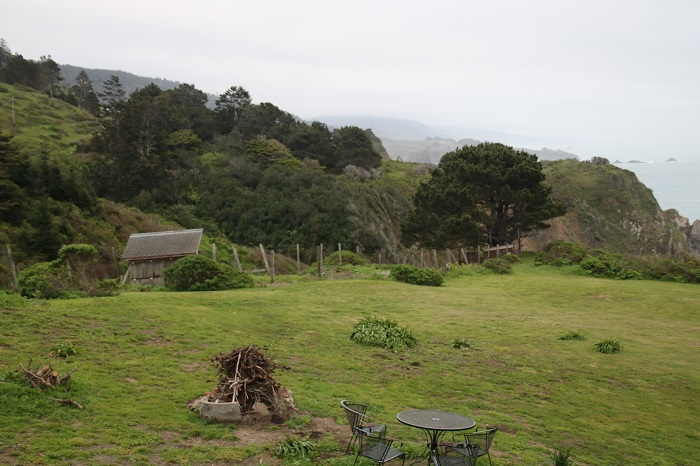 It’s been a real treat to spend a week with them, here and near their home in Oakland. They live in a lovely little studio apartment with their dog Mila. It’s way to small for us to stay with them, so off to an Air B&B for us. It’s an expensive area so I won’t comment on where we’ve been staying. Let’s just say that today’s view, well, it’s better.
It’s been a real treat to spend a week with them, here and near their home in Oakland. They live in a lovely little studio apartment with their dog Mila. It’s way to small for us to stay with them, so off to an Air B&B for us. It’s an expensive area so I won’t comment on where we’ve been staying. Let’s just say that today’s view, well, it’s better.
So, here we are, and it’s great. Chris and Melody set this up and are treating us to a stay with them high on a cliff overlooking the ocean. The place, and you can’t see another building from here, is located on 85 acres. Its a compound or tiny village with an eclectic mix of buildings. 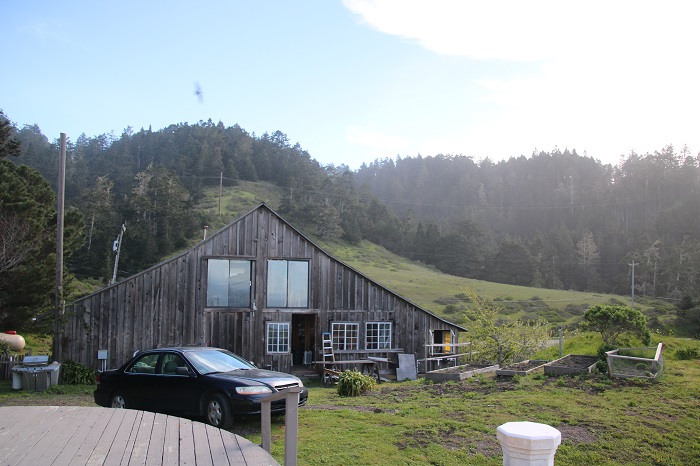 There’s even a root cellar, or is it a Hobbit House?
There’s even a root cellar, or is it a Hobbit House? 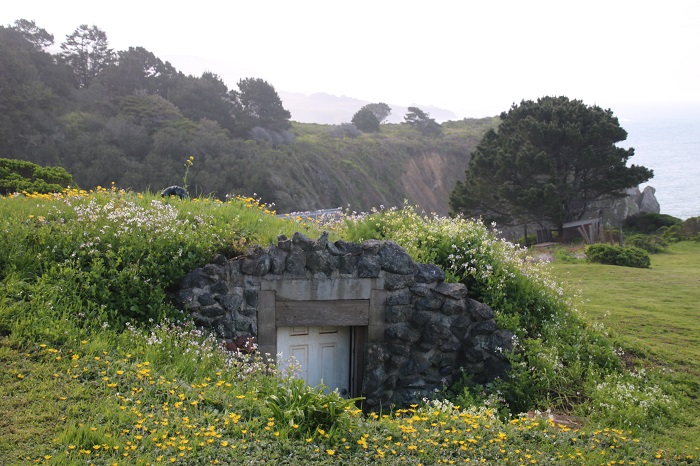 The view from the deck on the main house, where we are staying, is pretty spectacular.
The view from the deck on the main house, where we are staying, is pretty spectacular.  From the northern part of the property you get a pretty good feel for the scale of the place. You can barely see the main house peaking out from the trees on the left.
From the northern part of the property you get a pretty good feel for the scale of the place. You can barely see the main house peaking out from the trees on the left. 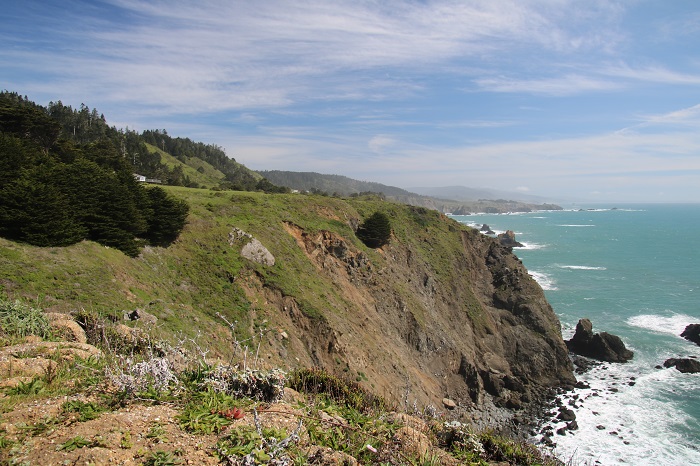 These trees to the left on the above photo look like they have had to work hard to grow here. Craggy and I expect very old.
These trees to the left on the above photo look like they have had to work hard to grow here. Craggy and I expect very old. 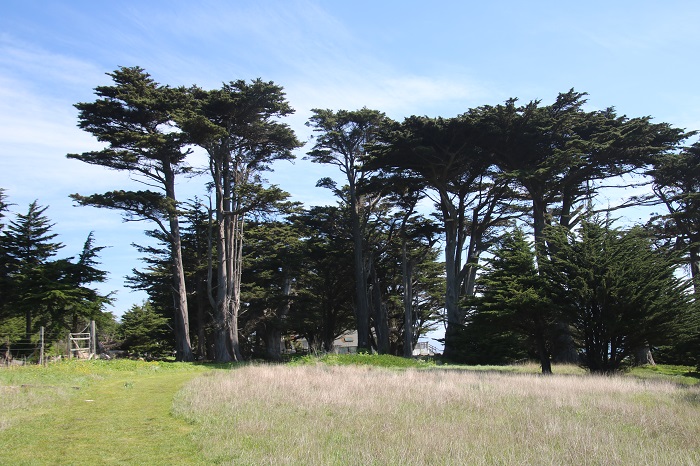 Out on the point, near the edge of the cliff, there are some wonderful spring flowers. These low lying fleshy plants grow everywhere.
Out on the point, near the edge of the cliff, there are some wonderful spring flowers. These low lying fleshy plants grow everywhere. 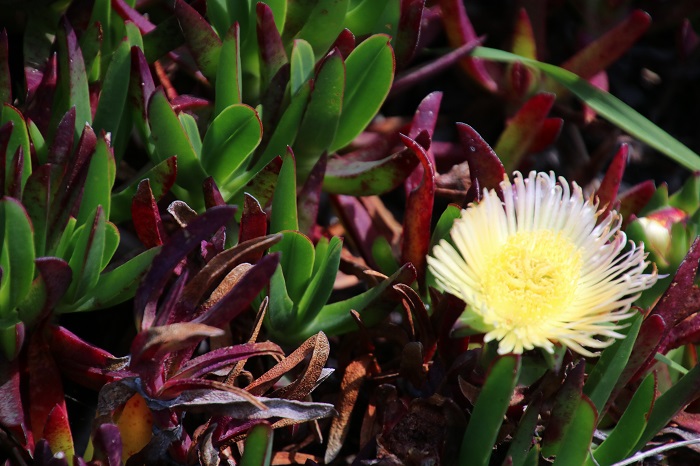 Love the dwarf iris, not more than 6″ tall.
Love the dwarf iris, not more than 6″ tall. 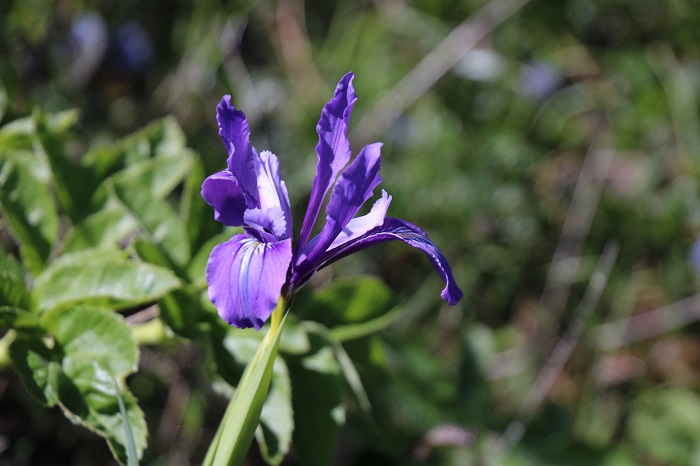 Near the northern property line, is a government survey mark placed here in 1930. It says that to disturb or remove it will subject me to a fine of $250 and imprisonment. $250 sounds like a pretty good deal for what would be a very nice souvenir. I wonder if they would calculate inflation from 1930 into account if I take it? Not sure about the “imprisonment” part. On second thought, I’ll leave it.
Near the northern property line, is a government survey mark placed here in 1930. It says that to disturb or remove it will subject me to a fine of $250 and imprisonment. $250 sounds like a pretty good deal for what would be a very nice souvenir. I wonder if they would calculate inflation from 1930 into account if I take it? Not sure about the “imprisonment” part. On second thought, I’ll leave it. Anyway, back to the flowers. I have no idea what this is but it is impressive with a flower stalk that is over 4′ tall.
Anyway, back to the flowers. I have no idea what this is but it is impressive with a flower stalk that is over 4′ tall.  These clusters are on a bush along with dozens more make for quite a show.
These clusters are on a bush along with dozens more make for quite a show. 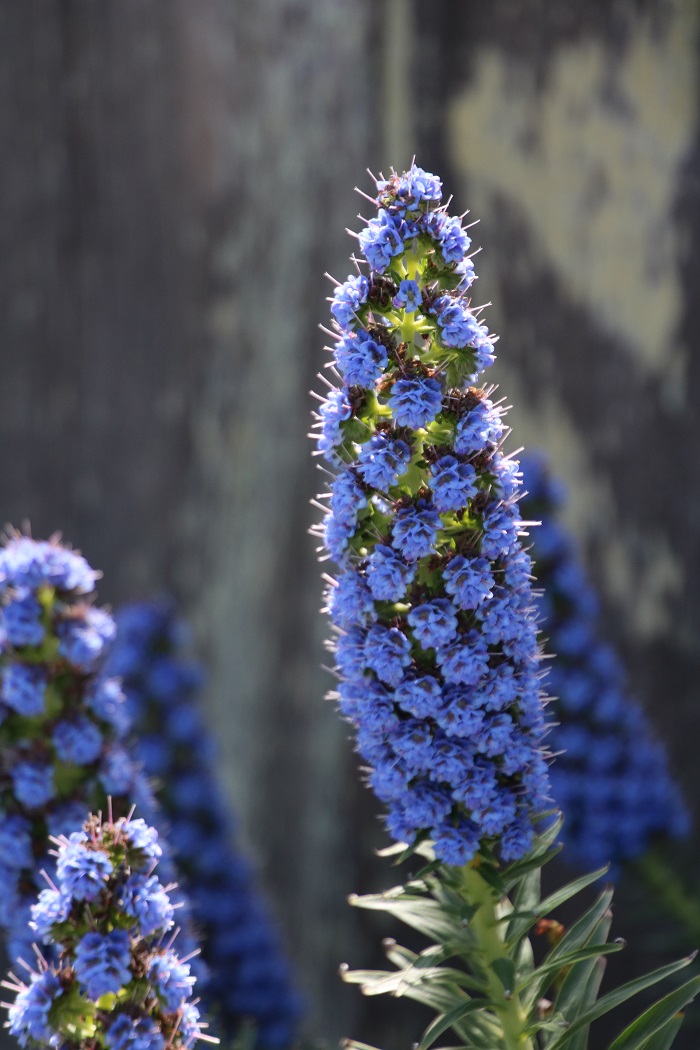 For lunch yesterday we stopped at a tiny deli in nearby Elk, population 250. There was a lovely picnic area across the street, overlooking a beach.
For lunch yesterday we stopped at a tiny deli in nearby Elk, population 250. There was a lovely picnic area across the street, overlooking a beach.
 Nice spot. Mila waiting for lunch to arrive. Melody in a lovely hat. I just love hats.
Nice spot. Mila waiting for lunch to arrive. Melody in a lovely hat. I just love hats. 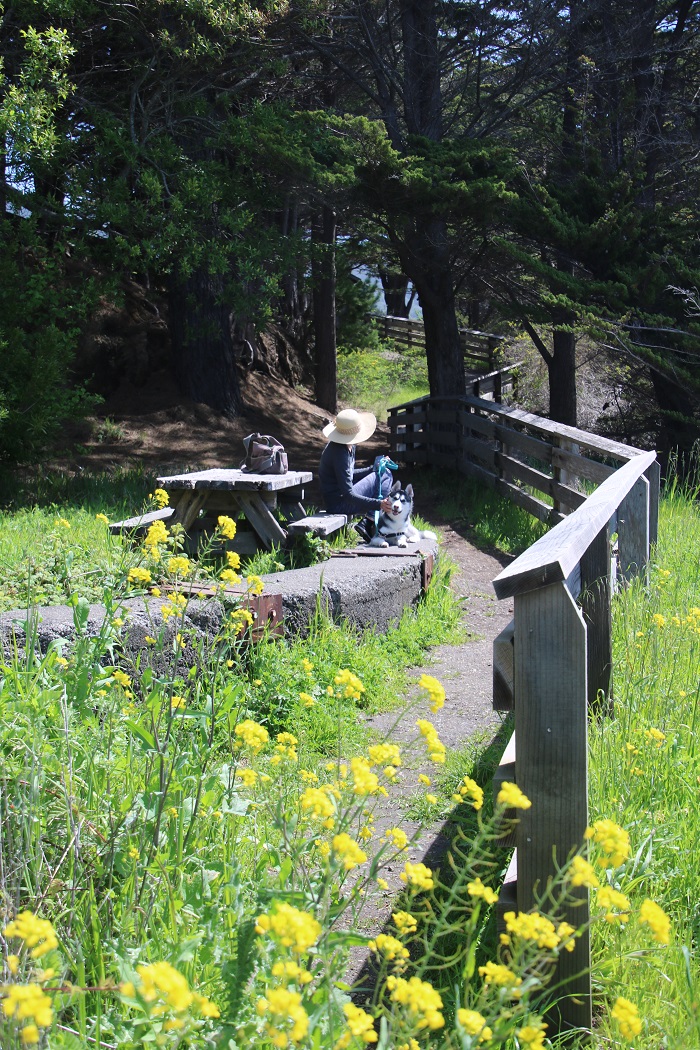 The Pacific coastline is remarkably rugged, with many miles between ports. By the mid 1800s, this area was a major source of lumber, shipped all over the world and a major source for the wood used to rebuild San Francisco following the devastating earthquake of 1906. This photo does suggest that they needed a lot of lumber.
The Pacific coastline is remarkably rugged, with many miles between ports. By the mid 1800s, this area was a major source of lumber, shipped all over the world and a major source for the wood used to rebuild San Francisco following the devastating earthquake of 1906. This photo does suggest that they needed a lot of lumber. Lumber schooners, mostly with two to three masts and easily maneuvered, were able to pull into just about any spot in the coastline that offered even a small amount of protection from the ocean swells. These harbors, such as they were, were known as “Dog-Hole Ports“, so named by the captains that used them because they were just large enough for a dog to get in and out of. There were some 400 sawmills along the northern California coastline serving these tiny ports. It’s hard to imagine bringing a ship near a rocky coastline like this, but they did.
Lumber schooners, mostly with two to three masts and easily maneuvered, were able to pull into just about any spot in the coastline that offered even a small amount of protection from the ocean swells. These harbors, such as they were, were known as “Dog-Hole Ports“, so named by the captains that used them because they were just large enough for a dog to get in and out of. There were some 400 sawmills along the northern California coastline serving these tiny ports. It’s hard to imagine bringing a ship near a rocky coastline like this, but they did.
This photo, BTW, was taken from the deck where we are staying. Amazing.  As close as we are to SF, about 3 hours by car, this areas once felt a lot more remote when it was only accessible by boat or stagecoach. In many ways, it still feels far away and very primitive. Well, primitive perhaps but with some really nice places to eat out and don’t forget about those wonderful wineries that are so close.
As close as we are to SF, about 3 hours by car, this areas once felt a lot more remote when it was only accessible by boat or stagecoach. In many ways, it still feels far away and very primitive. Well, primitive perhaps but with some really nice places to eat out and don’t forget about those wonderful wineries that are so close.
Yesterday evening we visited the nearby town of Mendocino for dinner. Before dinner we had drinks at a beautiful old inn from the late 1800s. I expect that our bar tab would have put us all up for a month, meals included, in the olden days. I also expect that the crowd would have been a bit rougher. “Hey you, yeah you dog face, get me another whisky and make it right quick or I’ll blow yer frigging head off! On second thought, a chardonnay if it’s not too much trouble.”
The trip here from San Francisco takes you through the major wine regions and finally winds through the redwood forest just north of the Anderson Valley, our favorite, and one area that Brenda and I have been visiting for over 30 years. It was a bit surreal for us to sit in the back seat on the way here as Chris drove us along those familiar roads. It wasn’t that long ago, well it doesn’t seem that long ago, since Brenda and I were in the area while Chris and his brother Rob were toddlers, home with their grandparents.
Melody and Chris just love it here. About 100 yards from the main house, there is a small deck that overlooks the very edge of the cliff. The wind off of the ocean is so strong that the chairs on the deck have to be tied with a rope to keep from being blown over the edge of the cliff. Not the most relaxing place to sit and sip wine. However, after a glass or so, the risk of falling to certain death somehow seems less of a problem. 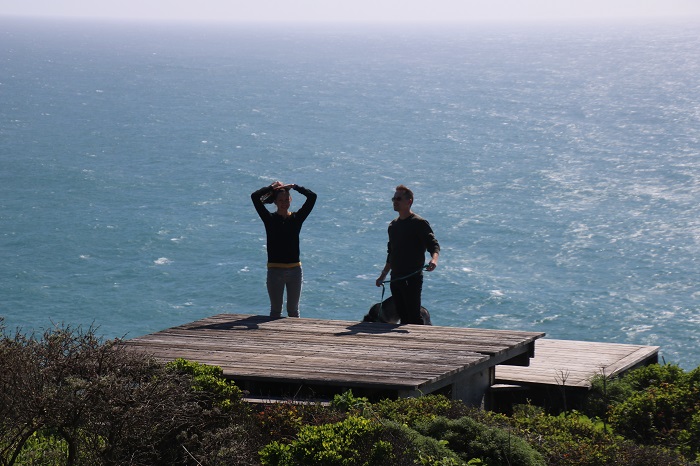 Their dog Mila loves surveying all that she can see. “Hey mom and dad, I’ll bet that cove is one of those Dog-Hole Ports. Am I right?”
Their dog Mila loves surveying all that she can see. “Hey mom and dad, I’ll bet that cove is one of those Dog-Hole Ports. Am I right?” 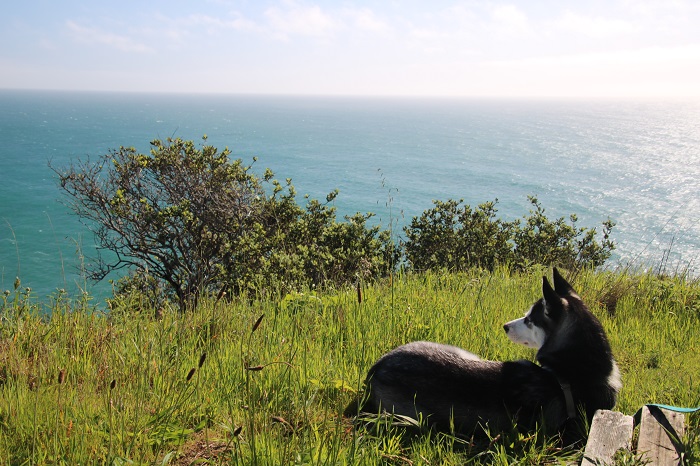 This area is very close too the dense redwood forest of the Navarro valley to the east, one of the areas that were heavily logged. As the coastline is so rugged, with safe harbors so far apart, transporting the lumber to anchored schooners involved a huge effort. Some spots, but not many, were sheltered enough to allow for the construction of a wharf that went far out into the water. Note the many lines strung from the bow of this steamer, no doubt to hold her off of the wharf in the ocean surge.
This area is very close too the dense redwood forest of the Navarro valley to the east, one of the areas that were heavily logged. As the coastline is so rugged, with safe harbors so far apart, transporting the lumber to anchored schooners involved a huge effort. Some spots, but not many, were sheltered enough to allow for the construction of a wharf that went far out into the water. Note the many lines strung from the bow of this steamer, no doubt to hold her off of the wharf in the ocean surge.
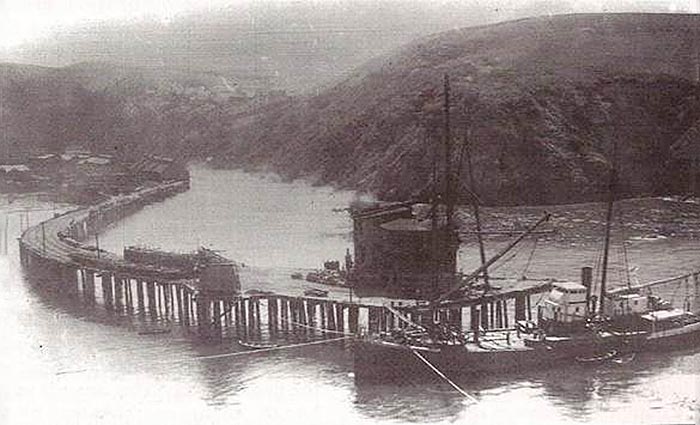 I expect that these structures did not last very long with the relentless pounding of ocean waves. However, with low cost labor along with cheap and abundant building materials, I doubt that it mattered.
I expect that these structures did not last very long with the relentless pounding of ocean waves. However, with low cost labor along with cheap and abundant building materials, I doubt that it mattered.
The often precipitous drop off from cliff to the water posed unique challenges in getting lumber down to the ship. 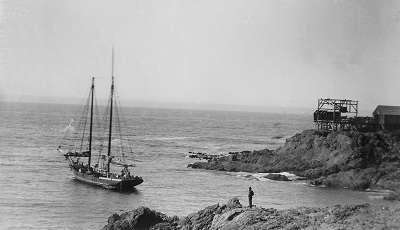 The only way, in those areas, to get materials down from high on the cliffs, was to use long lines strung from the top of the cliff or lumber shoots designed to slide boards down to the waiting schooner far below.
The only way, in those areas, to get materials down from high on the cliffs, was to use long lines strung from the top of the cliff or lumber shoots designed to slide boards down to the waiting schooner far below.  As technology improved, schooners made way for steam powered freighters but creativity was still needed to board freight and passengers. “Don’t worry little lady, I’ve done this hundreds of times.”
As technology improved, schooners made way for steam powered freighters but creativity was still needed to board freight and passengers. “Don’t worry little lady, I’ve done this hundreds of times.”
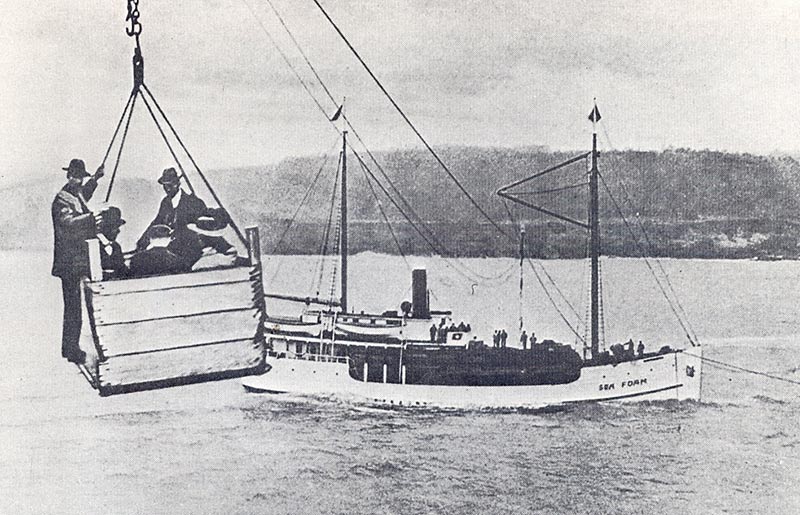 The schooners that served this area had to be very maneuverable in order to safely make their way in and out of the tiny harbors along this exposed coastline. It was easier to load the ships from high cliffs than to try and transport lumber any distance over rough dirt roads to better harbors.
The schooners that served this area had to be very maneuverable in order to safely make their way in and out of the tiny harbors along this exposed coastline. It was easier to load the ships from high cliffs than to try and transport lumber any distance over rough dirt roads to better harbors.
The last remaining lumber schooner from that era is the C.A. Thayer, launched in 1895 in Eureka CA, not far from here. She is now preserved at the San Francisco Maritime museum.  Over the years, she, along with a number of other vessels in the museums large collection, fell into an unfortunate state of disrepair but recently she has been fully restored.
Over the years, she, along with a number of other vessels in the museums large collection, fell into an unfortunate state of disrepair but recently she has been fully restored.
We visited her in 2017, on our last trip to SF, as they were just finishing the restoration and enjoyed a tour. She’s in great shape now.  Her stern was designed with openings that allowed the loading of long pieces of lumber below decks.
Her stern was designed with openings that allowed the loading of long pieces of lumber below decks. 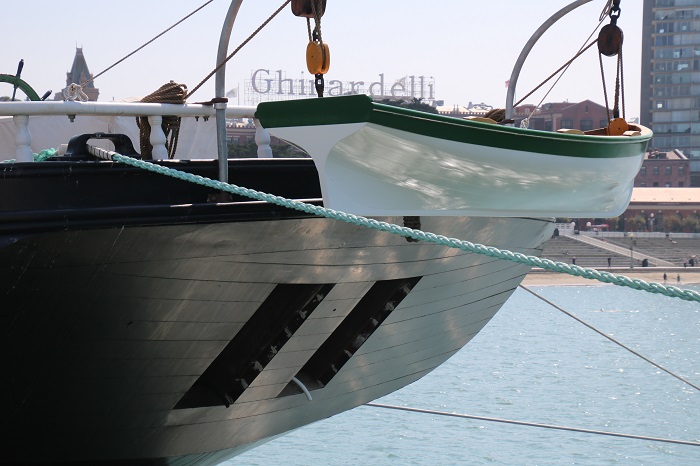 In order to fit the maximum amount of cargo, she was designed with no bulkheads below decks.
In order to fit the maximum amount of cargo, she was designed with no bulkheads below decks. 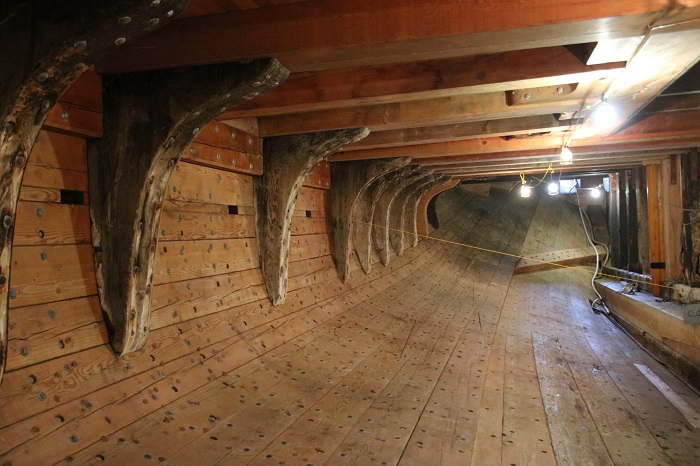 There were once hundreds of these schooners moving lumber down the coast to San Francisco but she is now the last remaining one and it was nice to see her restored to better than new condition.
There were once hundreds of these schooners moving lumber down the coast to San Francisco but she is now the last remaining one and it was nice to see her restored to better than new condition.
So, here we are, in an area with so much history and along with is us Mila, who must particularly appreciate the history behind these out of the way, “Dog-Hole ports” that played such an important part of area history.

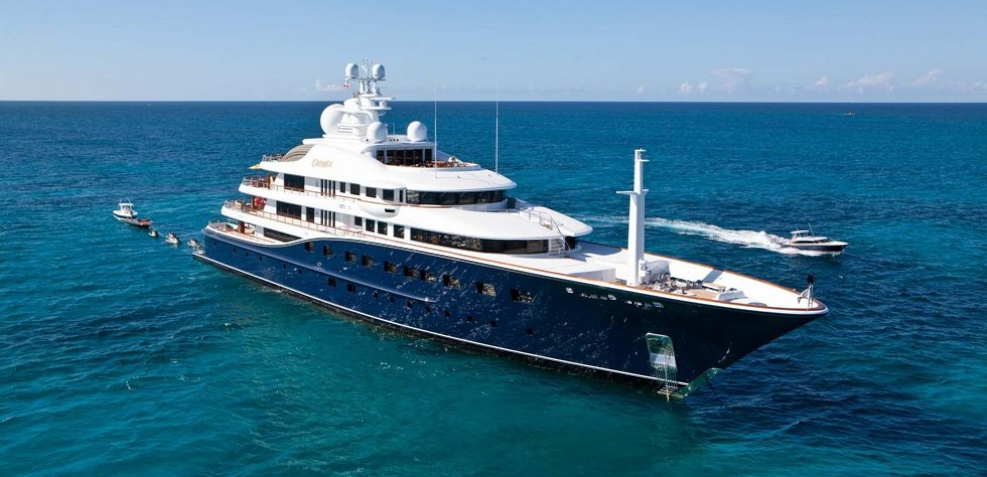 So, here I sit. It’s early April and I have a growing list of what has to happen to get her ready for the water. It’s like the old days before I retired but at least I don’t have to get up on a Monday morning and head to the office.
So, here I sit. It’s early April and I have a growing list of what has to happen to get her ready for the water. It’s like the old days before I retired but at least I don’t have to get up on a Monday morning and head to the office.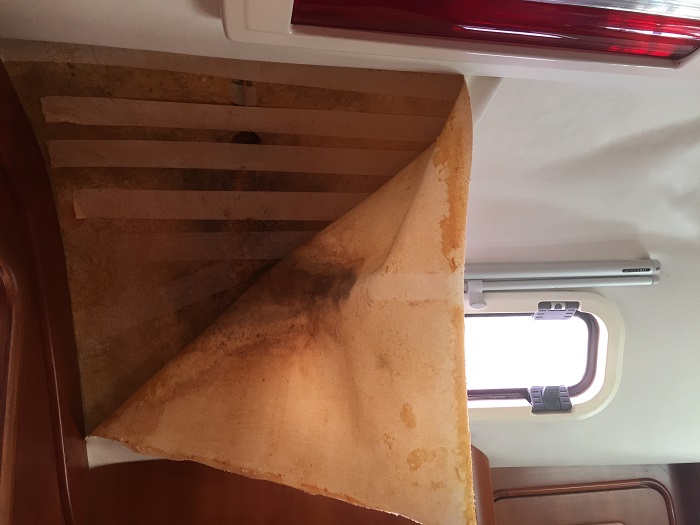 At first I thought that the problem was limited to a few areas. No such luck.
At first I thought that the problem was limited to a few areas. No such luck. So, I decided to take nearly all of it down. It was a huge job and very messy. I consulted with Chad, the canvas maker that did a great job on my cockpit enclosure, to get advice on what to do. He suggested that I pull the vinyl down and then, with a wire brush on a drill, have at it. This is a view of the aft cabin, where I pulled down all of the vinyl. Then the drill…
So, I decided to take nearly all of it down. It was a huge job and very messy. I consulted with Chad, the canvas maker that did a great job on my cockpit enclosure, to get advice on what to do. He suggested that I pull the vinyl down and then, with a wire brush on a drill, have at it. This is a view of the aft cabin, where I pulled down all of the vinyl. Then the drill…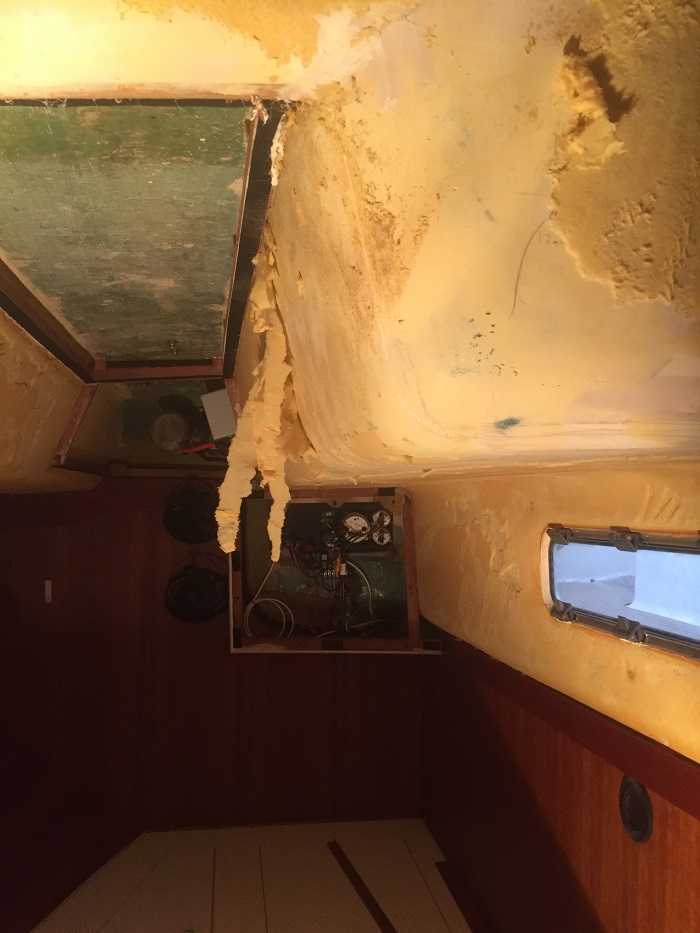 The main cabin, post wire brush. Looks like a derelict boat. Depressing. And such a mess…
The main cabin, post wire brush. Looks like a derelict boat. Depressing. And such a mess…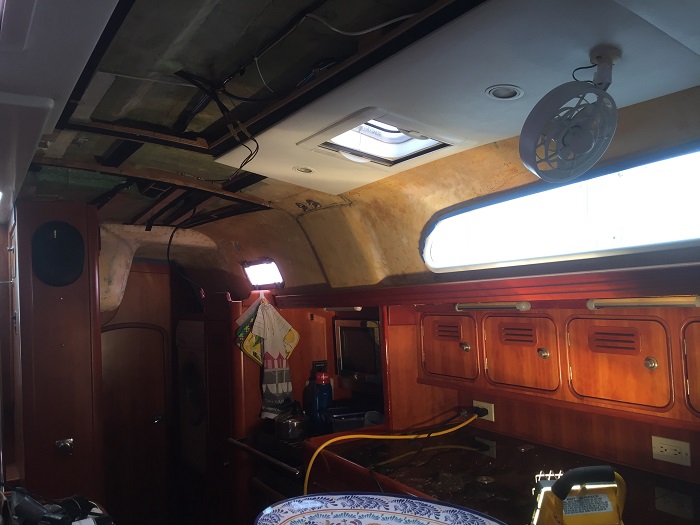 Over the weekend, I went to a sale at Defender, a discount marine supply company nearby. They have a once a year warehouse sale and it was mobbed. I purchased most of the lights I needed, along with a new
Over the weekend, I went to a sale at Defender, a discount marine supply company nearby. They have a once a year warehouse sale and it was mobbed. I purchased most of the lights I needed, along with a new  And, speaking of lights, I’ll also be replacing all of the inefficient fluorescent fixtures in the cabin and cockpit, along with all of the halogen bulbs in the overhead with LED bulbs and fixtures. The bad news is that the “footprint” of the old fixtures, and there are 9 of them, is larger than the new ones so that means that I’ll have to replace all the vinyl on other areas of the headliner that are basically fine to eliminate the old screw holes and stained vinyl in the areas around the old headliner. There are a LOT of fixtures to deal with. Fortunately, vinyl comes in many colors of “white” so we should be able to match the new to the old. Fingers crossed.
And, speaking of lights, I’ll also be replacing all of the inefficient fluorescent fixtures in the cabin and cockpit, along with all of the halogen bulbs in the overhead with LED bulbs and fixtures. The bad news is that the “footprint” of the old fixtures, and there are 9 of them, is larger than the new ones so that means that I’ll have to replace all the vinyl on other areas of the headliner that are basically fine to eliminate the old screw holes and stained vinyl in the areas around the old headliner. There are a LOT of fixtures to deal with. Fortunately, vinyl comes in many colors of “white” so we should be able to match the new to the old. Fingers crossed.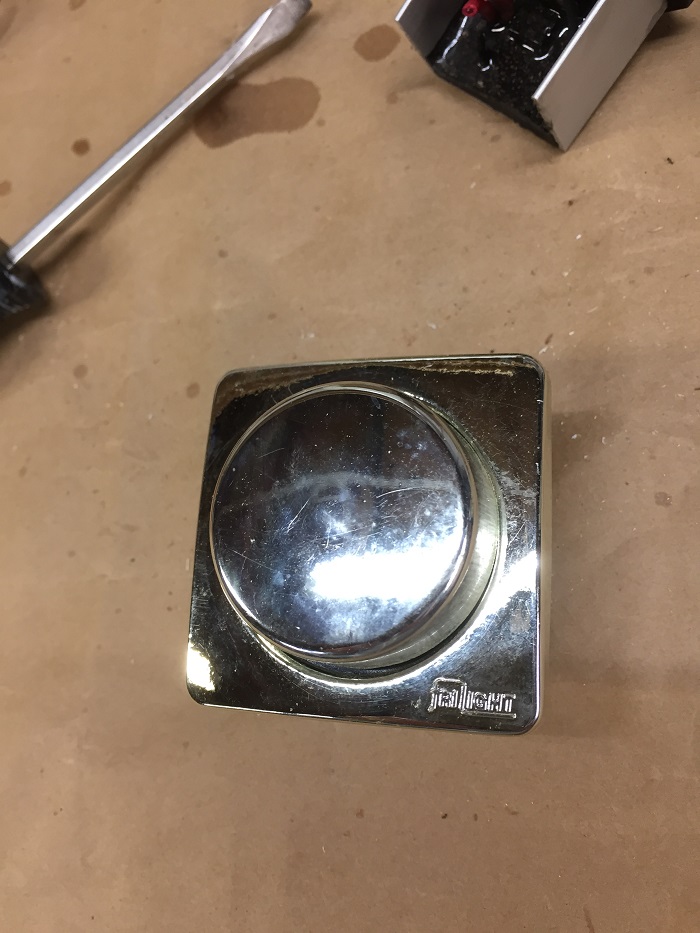 In spite of my best efforts, I could not locate new dimmers that look anything like these and would fit in the same 2″ hole. So, I decided to just “remodel” and use the same dimmer casing. So, I made up wooden inserts from scrap plywood that matched the interior.
In spite of my best efforts, I could not locate new dimmers that look anything like these and would fit in the same 2″ hole. So, I decided to just “remodel” and use the same dimmer casing. So, I made up wooden inserts from scrap plywood that matched the interior. 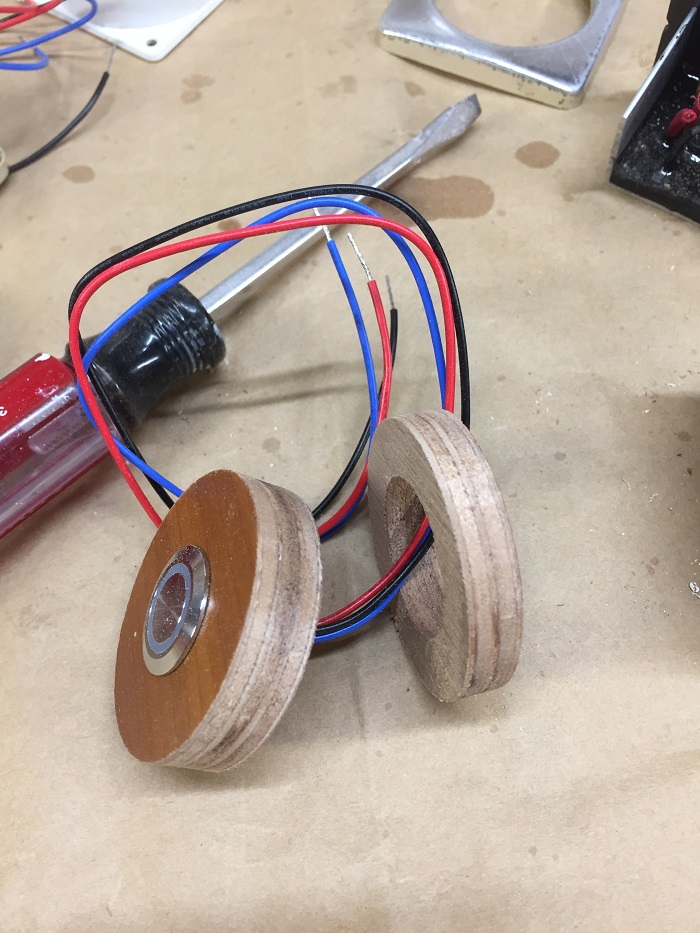 The plan will be to glue the new touch dimmer into the old housing and it will look like this. Pretty neat, right?
The plan will be to glue the new touch dimmer into the old housing and it will look like this. Pretty neat, right?  I’m pretty pleased with myself, frankly. An elegant solution that will minimize effort in matching the current holes.
I’m pretty pleased with myself, frankly. An elegant solution that will minimize effort in matching the current holes. Oh yeah, one more thing. Pandora has electric toilets. Can you imagine, electric? And mixing electricity with, well, you know what, is a messy business. The toilet, head, has three electric motors and one failed on the aft head so I had to put in another. If you think that this looks expensive, it is. Fortunately, I was able to get it replaced under warranted. Let’s hope that if it decides to “poop out” it does so before a year. Motors on a head? Who knew?
Oh yeah, one more thing. Pandora has electric toilets. Can you imagine, electric? And mixing electricity with, well, you know what, is a messy business. The toilet, head, has three electric motors and one failed on the aft head so I had to put in another. If you think that this looks expensive, it is. Fortunately, I was able to get it replaced under warranted. Let’s hope that if it decides to “poop out” it does so before a year. Motors on a head? Who knew? 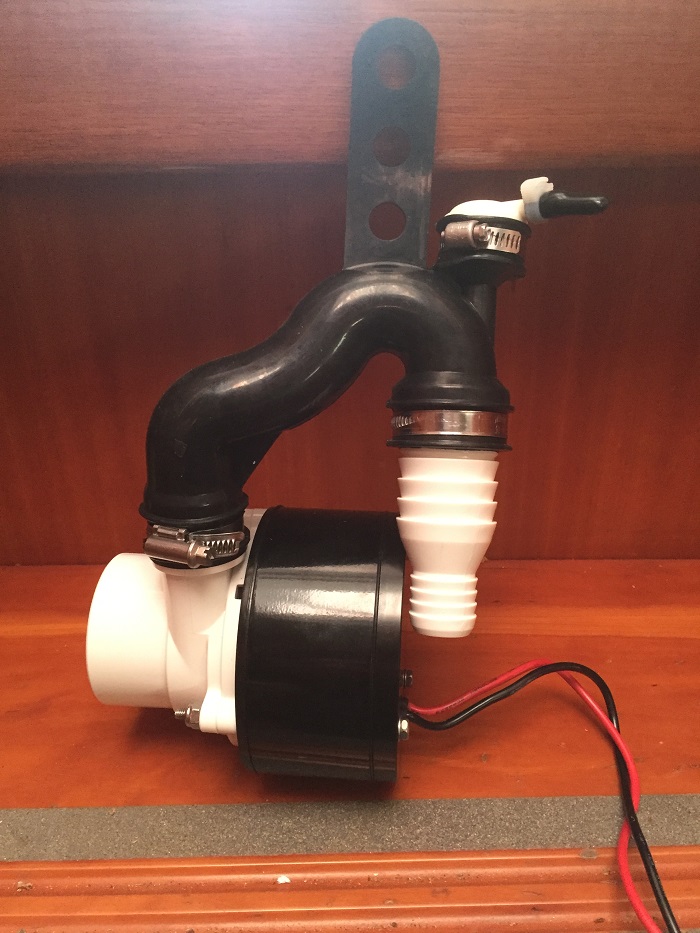 So, after a winter spent waiting for the weather to get warm enough to work on Pandora and time spent focusing on my “honey do list”, it’s time to get cracking and find a way to get Pandora back in the water and ready to cruise.
So, after a winter spent waiting for the weather to get warm enough to work on Pandora and time spent focusing on my “honey do list”, it’s time to get cracking and find a way to get Pandora back in the water and ready to cruise. Aboard were “Commander V.E.B” Nicholson his wife Emma and their two young sons who arrived in English Harbor, the site of the then derelict Nelson’s Dockyard where they decided to make a home.
Aboard were “Commander V.E.B” Nicholson his wife Emma and their two young sons who arrived in English Harbor, the site of the then derelict Nelson’s Dockyard where they decided to make a home. Over time, their older son, Desmond and his wife Lisa also became passionate about the historic Dockyard, looking beyond the caved in roofs and crumbling walls to envision what is today a national treasure, UNESCO world heritage site and the only operating Georgian Dockyard in the world
Over time, their older son, Desmond and his wife Lisa also became passionate about the historic Dockyard, looking beyond the caved in roofs and crumbling walls to envision what is today a national treasure, UNESCO world heritage site and the only operating Georgian Dockyard in the world This event proved to be the beginning of the first charter business in Antigua, that lives on today as Nicholson Yachts Charter & Services.
This event proved to be the beginning of the first charter business in Antigua, that lives on today as Nicholson Yachts Charter & Services. Today the grounds and customs office are fully restored. Nearly every inch of dock space in English Harbor and nearby Falmouth Harbor are crammed with all manner of mega-yachts and cruisers. Some of these behemoths look more like ocean liners than private yachts. I was told that in January there were some 80 mega-yachts in residence between English and Falmouth harbors.
Today the grounds and customs office are fully restored. Nearly every inch of dock space in English Harbor and nearby Falmouth Harbor are crammed with all manner of mega-yachts and cruisers. Some of these behemoths look more like ocean liners than private yachts. I was told that in January there were some 80 mega-yachts in residence between English and Falmouth harbors. 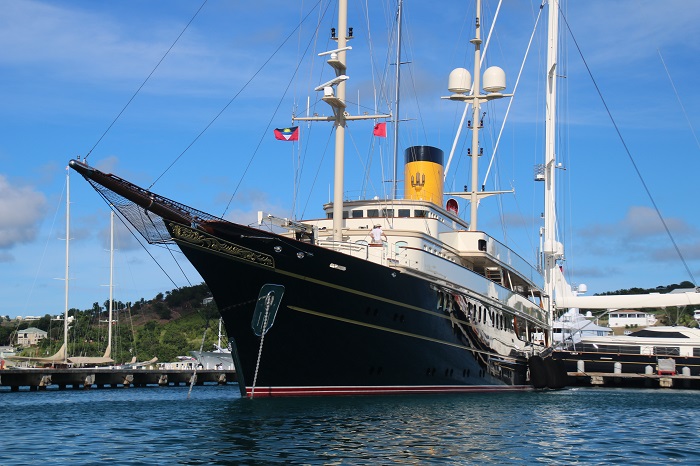 Shortly after arriving in Antigua, the Nicholson family received permission to take up residence in the abandoned Dockyard and set about doing what they could to improve the facility. No drones in those days. These photos were taken after much of the rebuilding was done, replacing missing roofs and walls.
Shortly after arriving in Antigua, the Nicholson family received permission to take up residence in the abandoned Dockyard and set about doing what they could to improve the facility. No drones in those days. These photos were taken after much of the rebuilding was done, replacing missing roofs and walls.  Today the look of the Dockyard is true to it’s roots and looks much like it did when it was the Caribbean base for the British Navy with all of the buildings beautifully restored. In 2016 the Dockyard was designated as a
Today the look of the Dockyard is true to it’s roots and looks much like it did when it was the Caribbean base for the British Navy with all of the buildings beautifully restored. In 2016 the Dockyard was designated as a 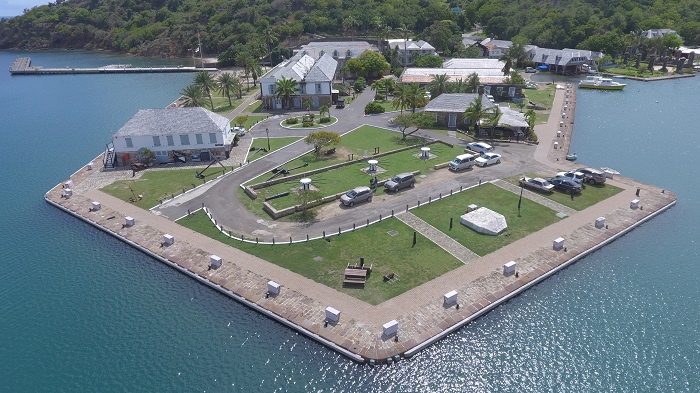 The Dockyard doesn’t look all that different these days than it did when Desmond took this photo.
The Dockyard doesn’t look all that different these days than it did when Desmond took this photo. 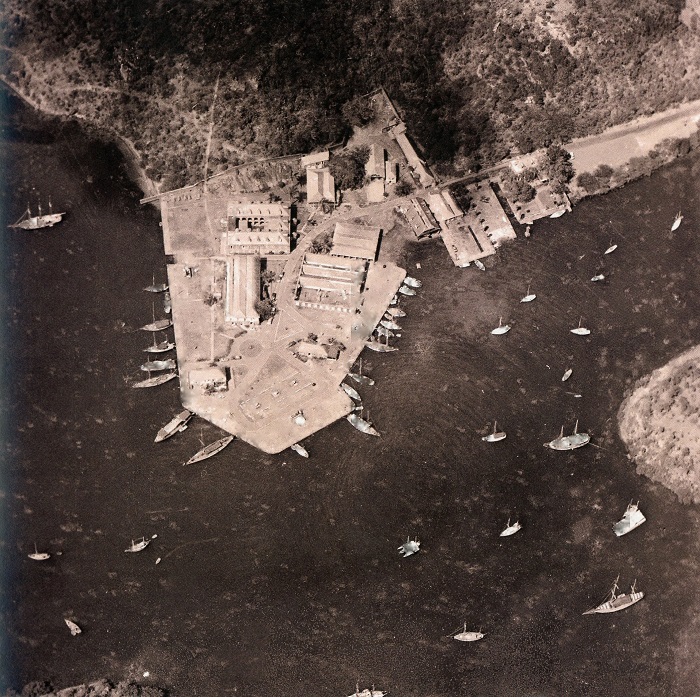 Well, one thing that is different is that there are a LOT more boats. This is a photo of boats participating in the Oyster round the world rally from a few years ago. I have a friend who had hoped to meet me there this April as they return, having completed a circumnavigation themselves as part of the rally. I wish that I could be there. Next year…
Well, one thing that is different is that there are a LOT more boats. This is a photo of boats participating in the Oyster round the world rally from a few years ago. I have a friend who had hoped to meet me there this April as they return, having completed a circumnavigation themselves as part of the rally. I wish that I could be there. Next year… There are still remnants of the careening dock that was used to pull over navy ships for bottom work. The Nicholson family used similar equipment to restore yachts in the early years. Nowadays, right across the harbor, there is a full service yard with a railway servicing yachts of all sizes.
There are still remnants of the careening dock that was used to pull over navy ships for bottom work. The Nicholson family used similar equipment to restore yachts in the early years. Nowadays, right across the harbor, there is a full service yard with a railway servicing yachts of all sizes.  Most everyone visiting the island makes the pilgrimage up to the British Navy era
Most everyone visiting the island makes the pilgrimage up to the British Navy era 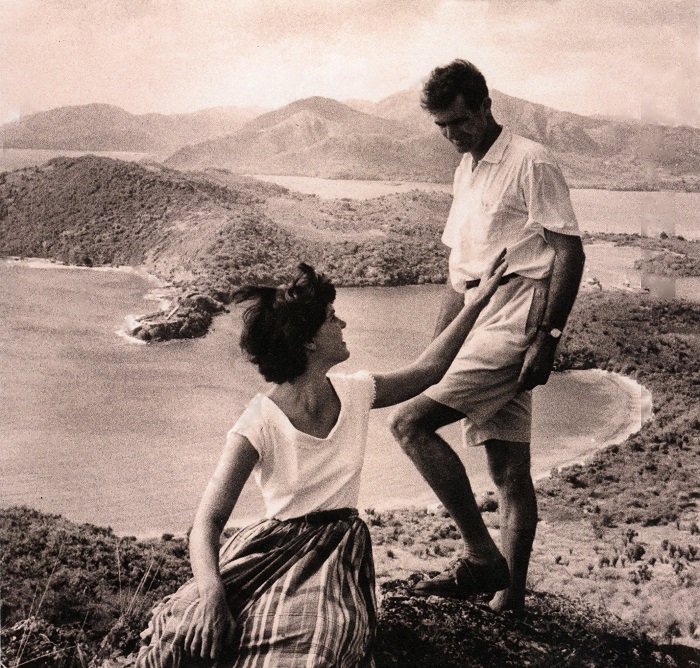
 The Lookout is still a tremendously popular spot to watch the sunset for locals and visitors alike with barbecues and bands performing at sunset every week.
The Lookout is still a tremendously popular spot to watch the sunset for locals and visitors alike with barbecues and bands performing at sunset every week.  Crowds or not, this view will never be beat and no less lovely than it was when the Nicholson family first made landfall. It’s no wonder that they decided to stay and make a life for themselves on the island.
Crowds or not, this view will never be beat and no less lovely than it was when the Nicholson family first made landfall. It’s no wonder that they decided to stay and make a life for themselves on the island.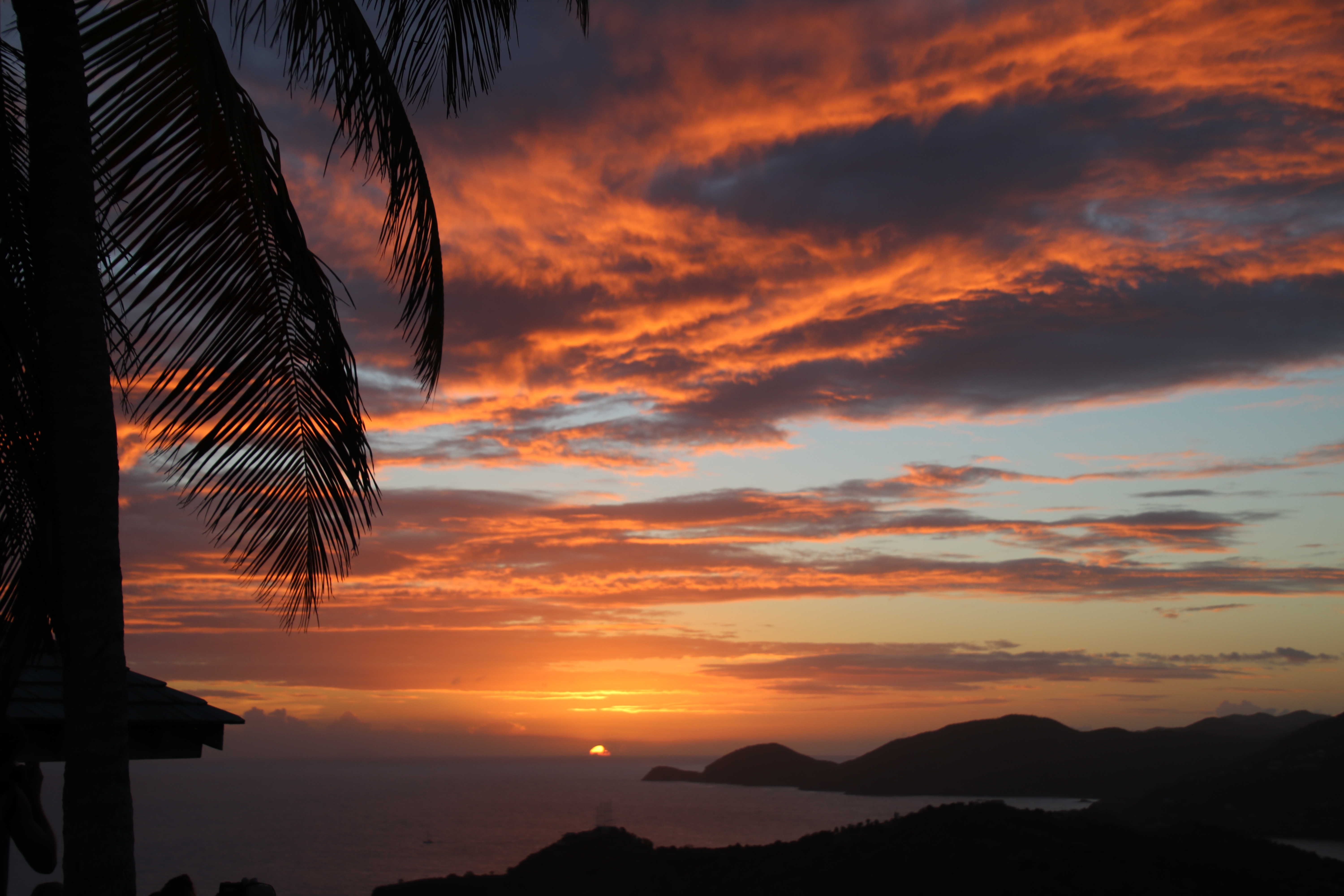 Sail making has always been a part of the Dockyard, including during Desmond’s time. I’ll bet that the figurehead in the corner has an interesting story to tell.
Sail making has always been a part of the Dockyard, including during Desmond’s time. I’ll bet that the figurehead in the corner has an interesting story to tell.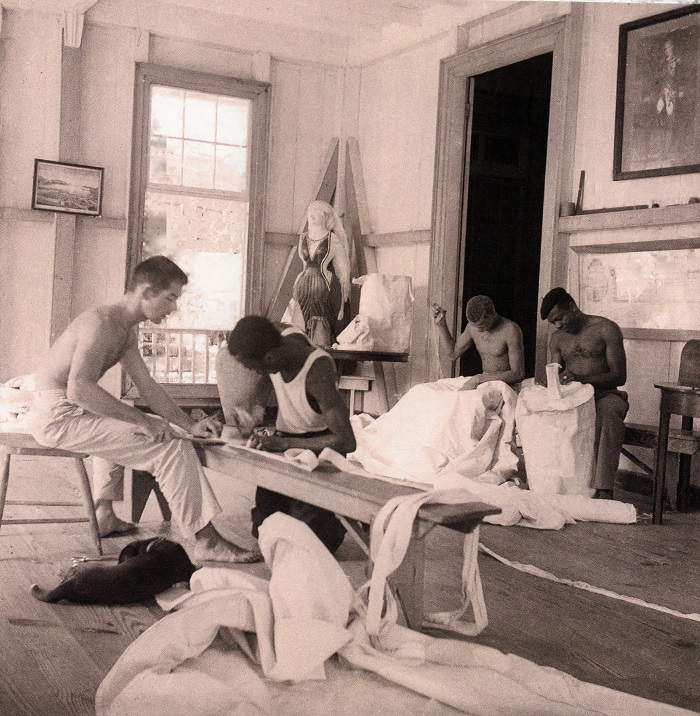 And that craft remains a vital part of the Dockyard today. A&F Sails is located in the Dockyard, owned and operated by the Commodore of the Antigua Yacht Club, Franklyn Braithwaite. He’s a great guy and has been tremendously supportive of the Salty Dawg Rally.
And that craft remains a vital part of the Dockyard today. A&F Sails is located in the Dockyard, owned and operated by the Commodore of the Antigua Yacht Club, Franklyn Braithwaite. He’s a great guy and has been tremendously supportive of the Salty Dawg Rally.  In addition to Franklyn’s loft, the Dockyard is home to many marine related businesses. These stone pillars, now part of the Admiral’s Inn, were once the base of the loft that took care of the sails for naval ships. In Nelson’s day, the channel between the columns allowed ships’ gigs to row under the building and have sails lifted into the loft for service.
In addition to Franklyn’s loft, the Dockyard is home to many marine related businesses. These stone pillars, now part of the Admiral’s Inn, were once the base of the loft that took care of the sails for naval ships. In Nelson’s day, the channel between the columns allowed ships’ gigs to row under the building and have sails lifted into the loft for service. 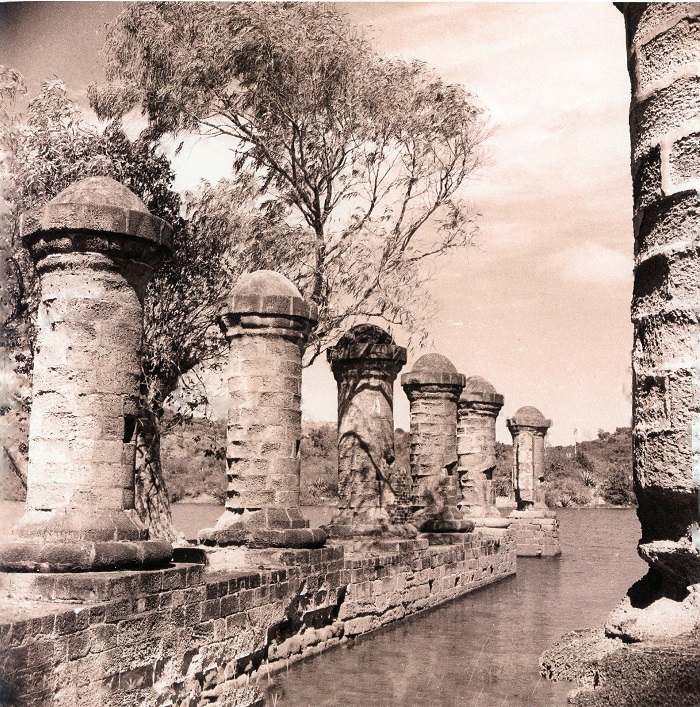 Today they serve as an iconic backdrop for the
Today they serve as an iconic backdrop for the  The Dockyard plays a big role in the arrival of the Salty Dawg fleet. We have a number of events in the Dockyard and cap our week of celebration with a dinner by the pool at Boom, part of the Admiral’s Inn.
The Dockyard plays a big role in the arrival of the Salty Dawg fleet. We have a number of events in the Dockyard and cap our week of celebration with a dinner by the pool at Boom, part of the Admiral’s Inn.  The view of the dockyard from that spot is really impressive.
The view of the dockyard from that spot is really impressive. 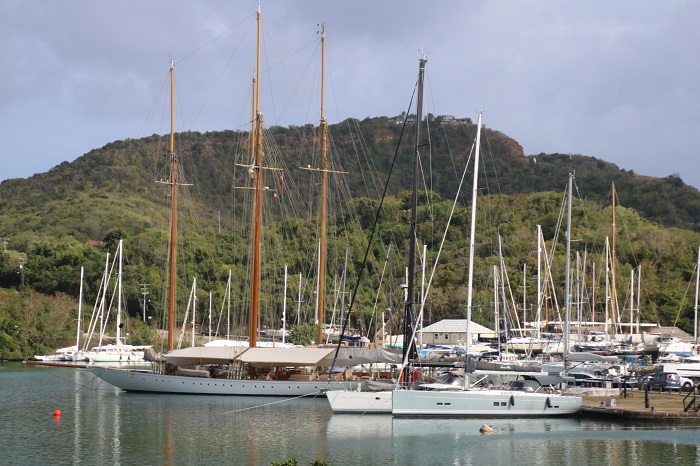 Across the harbor from the Dockyard, is
Across the harbor from the Dockyard, is  Today English Harbor and Nelson’s Dockyard remain a vital harbor for cruising and charter yachts alike and it all began with the arrival of Commander Nicholson and his family so many years ago.
Today English Harbor and Nelson’s Dockyard remain a vital harbor for cruising and charter yachts alike and it all began with the arrival of Commander Nicholson and his family so many years ago. So many years have come and gone since Mollihawk arrived in English Harbor but the legacy remains, a good example of how important the vision and work of even a single family can be.
So many years have come and gone since Mollihawk arrived in English Harbor but the legacy remains, a good example of how important the vision and work of even a single family can be. There are a number of options for heading to the Caribbean from the US east coast. Beyond where to make landfall, a key question is about how convenient it is to explore the rest of the islands once you arrive.
There are a number of options for heading to the Caribbean from the US east coast. Beyond where to make landfall, a key question is about how convenient it is to explore the rest of the islands once you arrive.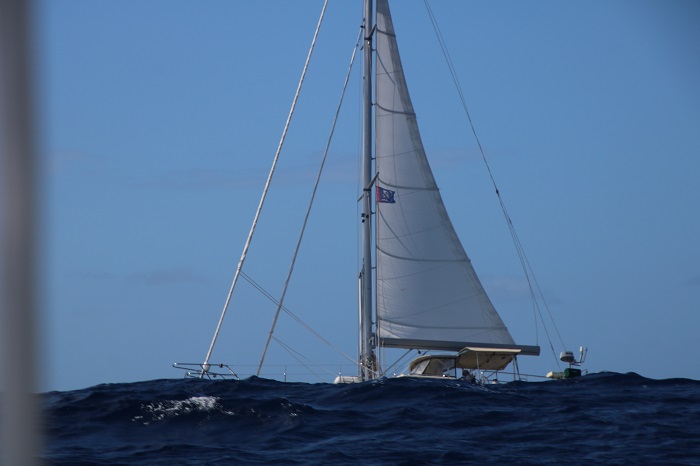 Several years ago, Brenda and I made the run between the British Virgin Islands and St Martin and in spite of light easterlies of only 10kts, it was quite an unpleasant trip, very bumpy motor sailing directly into the wind and waves that made for a VERY LONG DAY that began before sunrise and lasted until long after dark.
Several years ago, Brenda and I made the run between the British Virgin Islands and St Martin and in spite of light easterlies of only 10kts, it was quite an unpleasant trip, very bumpy motor sailing directly into the wind and waves that made for a VERY LONG DAY that began before sunrise and lasted until long after dark.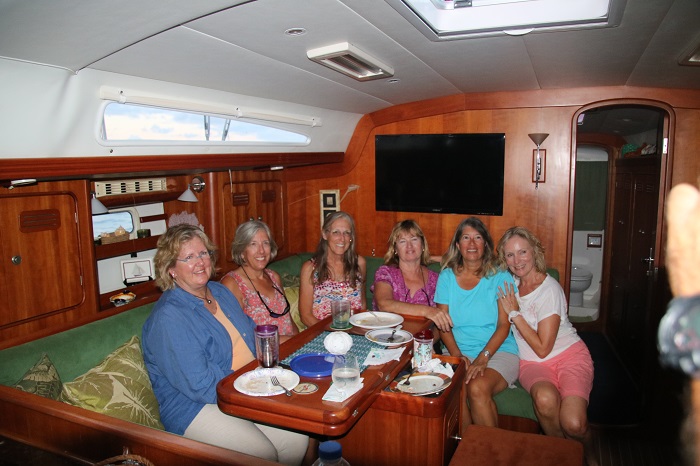 If you need a place to keep your boat when you head home for the holidays, dockage, moorings and marina storage in Antigua are a lot less expensive than you might think and flights home for the holidays are convenient and reasonably priced.
If you need a place to keep your boat when you head home for the holidays, dockage, moorings and marina storage in Antigua are a lot less expensive than you might think and flights home for the holidays are convenient and reasonably priced.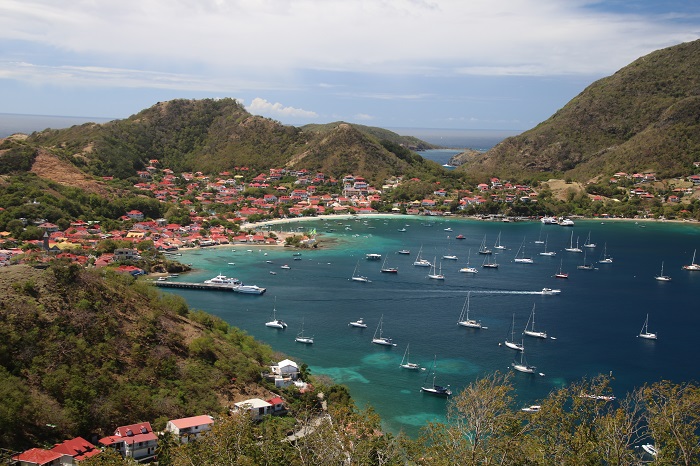
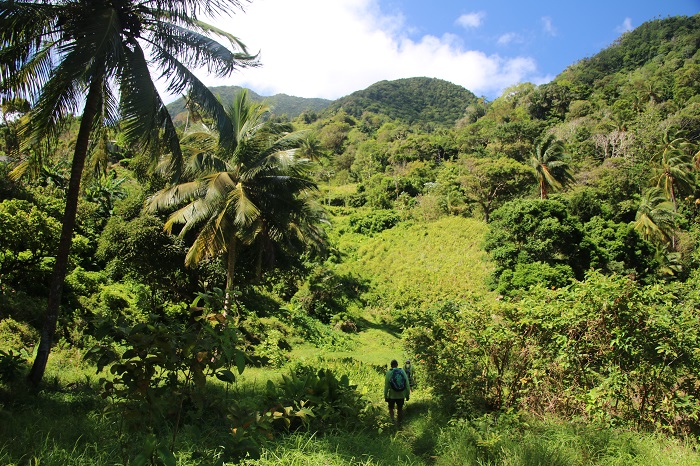 Love waterfalls? Dominica’s got that…
Love waterfalls? Dominica’s got that…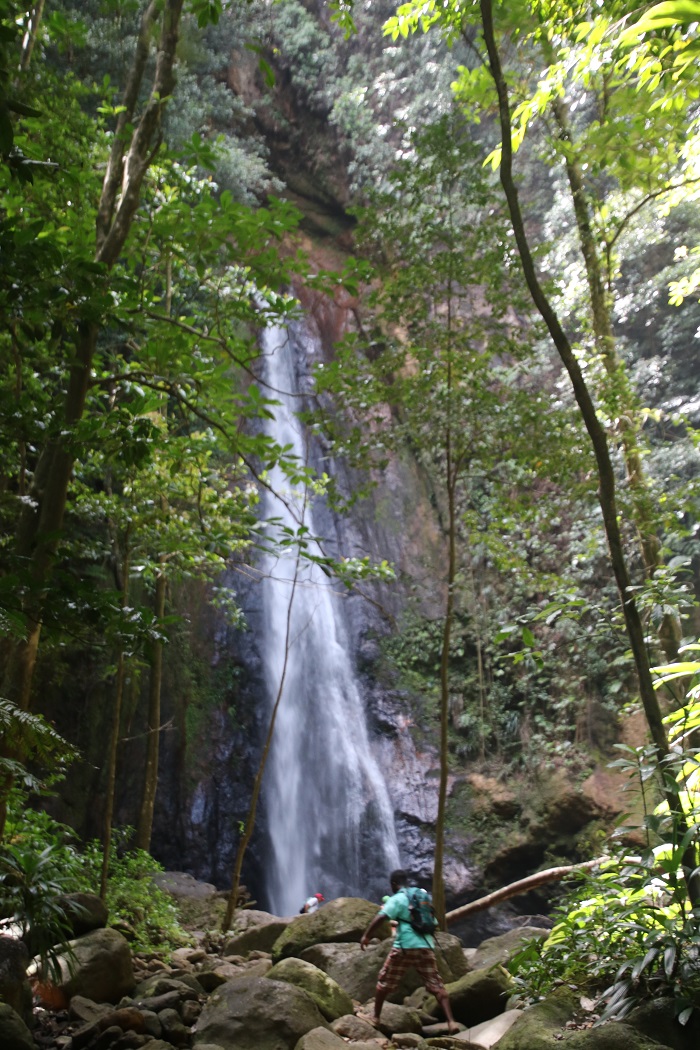 There are often questions about safety and crime in the Caribbean and while it’s always a good idea to keep your dink locked when on shore and tied to the boat at night, crime is mostly concentrated in certain areas of St Lucia and much of St Vincent. A bit farther south, Bequia and the Grenadines are wonderful and safe.
There are often questions about safety and crime in the Caribbean and while it’s always a good idea to keep your dink locked when on shore and tied to the boat at night, crime is mostly concentrated in certain areas of St Lucia and much of St Vincent. A bit farther south, Bequia and the Grenadines are wonderful and safe.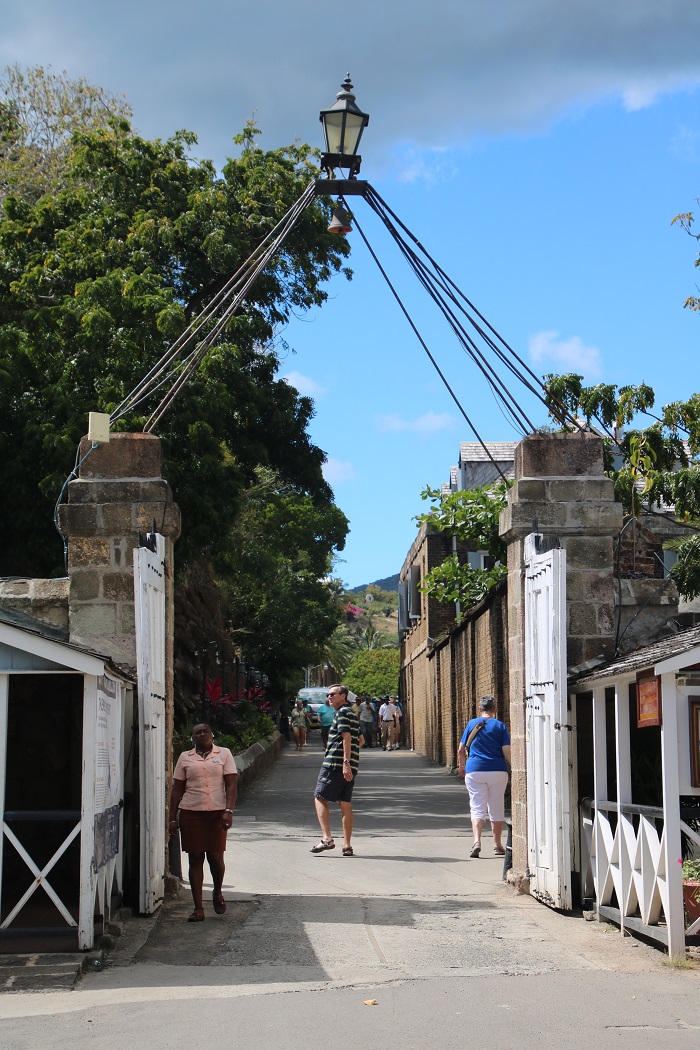 It’s a truly beautiful place.
It’s a truly beautiful place.  And loaded with fabulous yachts of all sizes.
And loaded with fabulous yachts of all sizes. 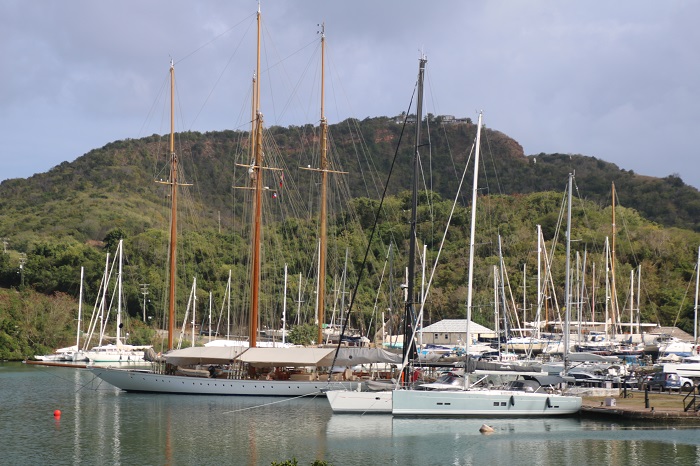 Yes, Antigua is the ideal place to begin your season and from there you can head further south without beating into the trade winds. And, as the season winds down you may choose, as many do, to leave your boat south in Grenada or Trinidad where you’ll be safe from the seasonal hurricanes.
Yes, Antigua is the ideal place to begin your season and from there you can head further south without beating into the trade winds. And, as the season winds down you may choose, as many do, to leave your boat south in Grenada or Trinidad where you’ll be safe from the seasonal hurricanes.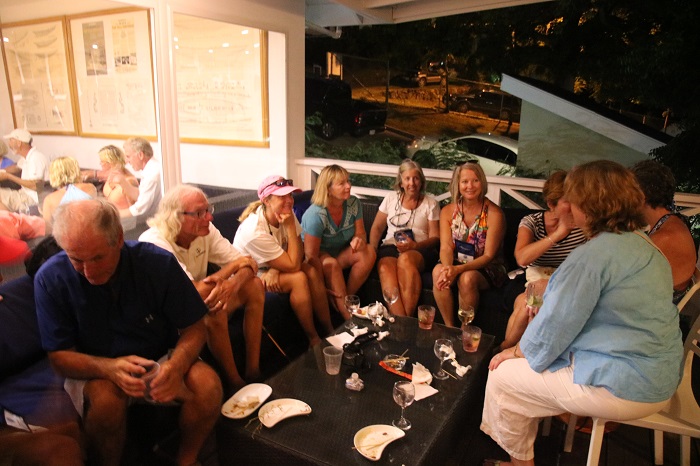 If you’ve been to Antigua in the past you know that what I am saying is true and I am sure that you won’t be disappointed by your next trip. If you are new to cruising the area, trust me, making landfall in Antigua and tying up in historic Nelson’s Dockyard for the first time will give you and your crew a thrill to be in a magical place that has hosted sailing vessels for hundreds of years, a
If you’ve been to Antigua in the past you know that what I am saying is true and I am sure that you won’t be disappointed by your next trip. If you are new to cruising the area, trust me, making landfall in Antigua and tying up in historic Nelson’s Dockyard for the first time will give you and your crew a thrill to be in a magical place that has hosted sailing vessels for hundreds of years, a  Still need convincing? Contact me, Antigua Port Captain for the Salty Dawg Rally, SDSA board member and I’ll answer your questions. Believe me, if Antigua wasn’t such a great spot, I wouldn’t be spending so much of my time working to make your arrival a great experience.
Still need convincing? Contact me, Antigua Port Captain for the Salty Dawg Rally, SDSA board member and I’ll answer your questions. Believe me, if Antigua wasn’t such a great spot, I wouldn’t be spending so much of my time working to make your arrival a great experience. Or perhaps for a glass of wine as the sun goes down.
Or perhaps for a glass of wine as the sun goes down. 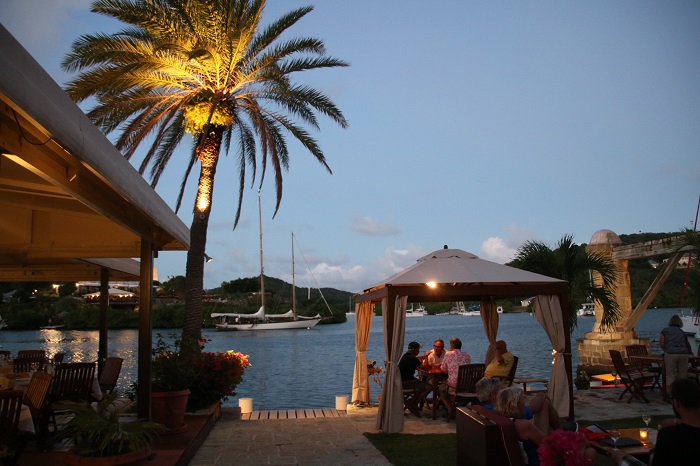 Pandora will be in the Dockyard waiting for you.
Pandora will be in the Dockyard waiting for you. 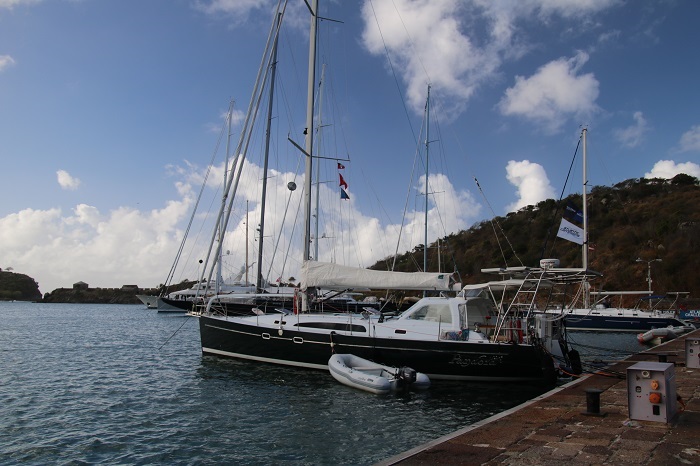 Well, that’s assuming that you don’t get there first.
Well, that’s assuming that you don’t get there first. So, why would you miss out on this?
So, why would you miss out on this?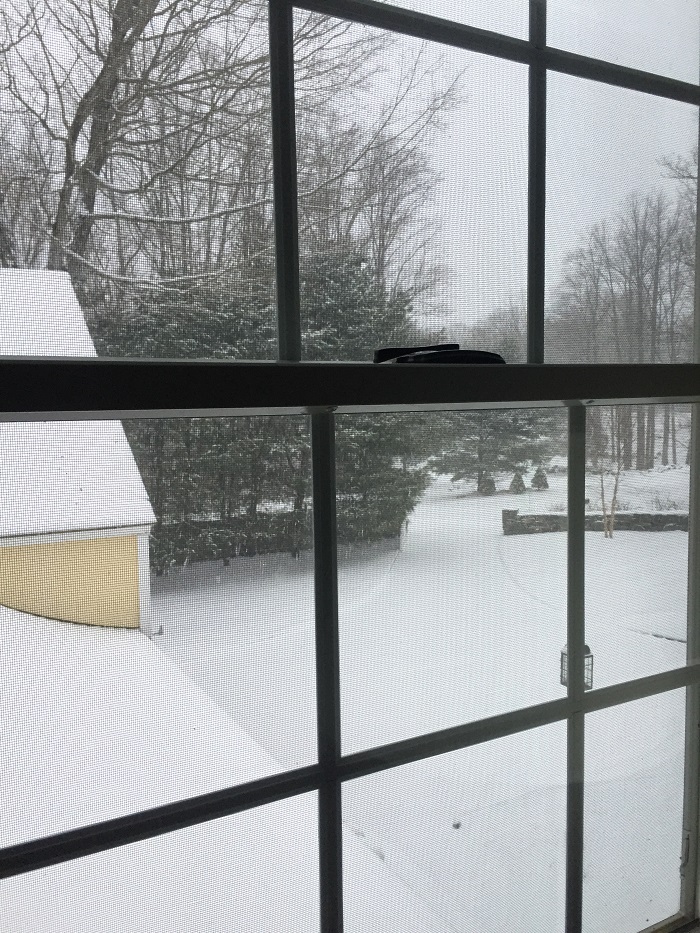 Beautiful yes, in a wintry sort of way. Me, I prefer this instead. Soon enough. It’l get better in May.
Beautiful yes, in a wintry sort of way. Me, I prefer this instead. Soon enough. It’l get better in May. Yes, it’s been tough for me to be here in CT with the sub-freezing weather for months now but at least I have been spending a lot of time in the the shop with no windows so I can’t see outside, the bare trees and… well, you get the picture. Actually, I already showed you the picture.
Yes, it’s been tough for me to be here in CT with the sub-freezing weather for months now but at least I have been spending a lot of time in the the shop with no windows so I can’t see outside, the bare trees and… well, you get the picture. Actually, I already showed you the picture.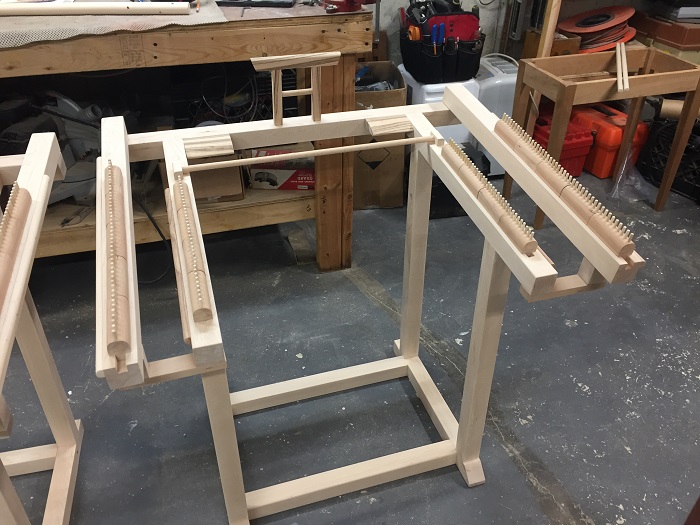 The loom looks deceptively simple, but, trust me, it’s not simple to make at all. I used some exotic materials including zebra wood. I have had a single board on hand in the shop for a decade waiting for the right project to come along.
The loom looks deceptively simple, but, trust me, it’s not simple to make at all. I used some exotic materials including zebra wood. I have had a single board on hand in the shop for a decade waiting for the right project to come along. 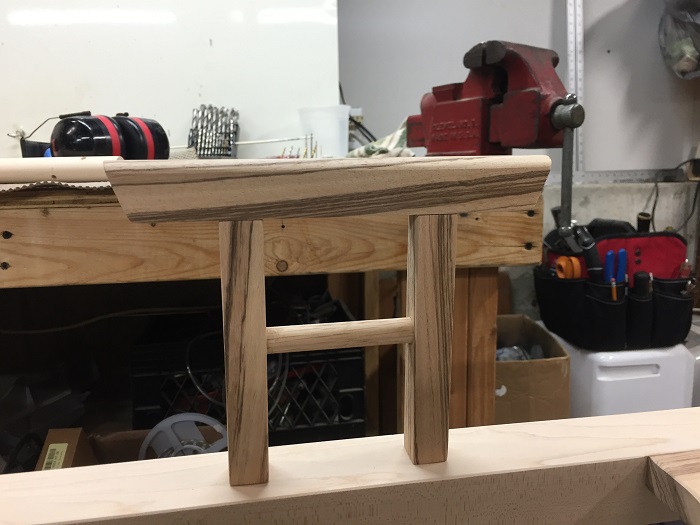 I also had to make 40 of these. They are called Koma and each one has 9 pins inserted into fiddly little holes. Yikes, talk about repetitive motion…
I also had to make 40 of these. They are called Koma and each one has 9 pins inserted into fiddly little holes. Yikes, talk about repetitive motion…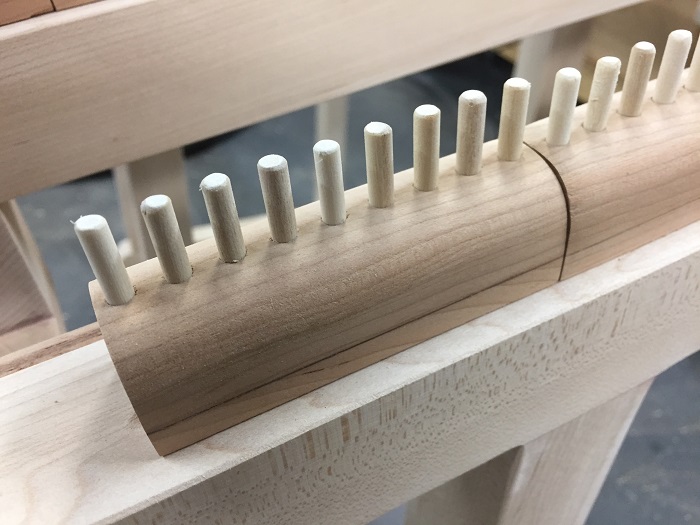
 And that’s just one of the two looms I made. To set up jigs to make all the parts took plenty of time so I decided to go ahead and make two of everything. Brenda plans on selling one of them to another weaver.
And that’s just one of the two looms I made. To set up jigs to make all the parts took plenty of time so I decided to go ahead and make two of everything. Brenda plans on selling one of them to another weaver.  Feed me, FEED ME “Tepe”!!! That’s Tori’s name for me, Grandpa. Double adorable. The best thing about being the oldest is that you get “naming rights”.
Feed me, FEED ME “Tepe”!!! That’s Tori’s name for me, Grandpa. Double adorable. The best thing about being the oldest is that you get “naming rights”.  The morning after we returned home from our visit, Brenda and I both were struck by how peaceful it was to have coffee and read the paper in ABSOLUTE SILENCE. We miss them but not until after that second cup of coffee and an hour spent reading the paper. Such are the joys of being a grandparent.
The morning after we returned home from our visit, Brenda and I both were struck by how peaceful it was to have coffee and read the paper in ABSOLUTE SILENCE. We miss them but not until after that second cup of coffee and an hour spent reading the paper. Such are the joys of being a grandparent. But wait, there’s more… I’ve been asked to give a talk on
But wait, there’s more… I’ve been asked to give a talk on 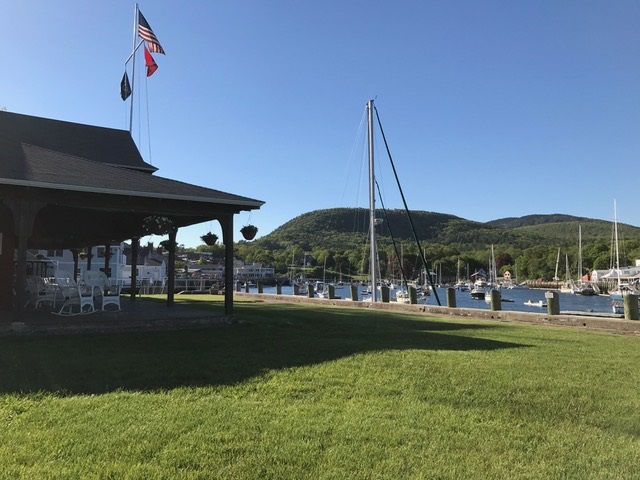 Other than that, I’m just hanging around waiting for the crocus to come up hinting that spring is just around the corner. And, now that the “takawhatervers” are nearly done, I can turn my attention back to Pandora so that I’ll be ready in time for some summer cruising.
Other than that, I’m just hanging around waiting for the crocus to come up hinting that spring is just around the corner. And, now that the “takawhatervers” are nearly done, I can turn my attention back to Pandora so that I’ll be ready in time for some summer cruising.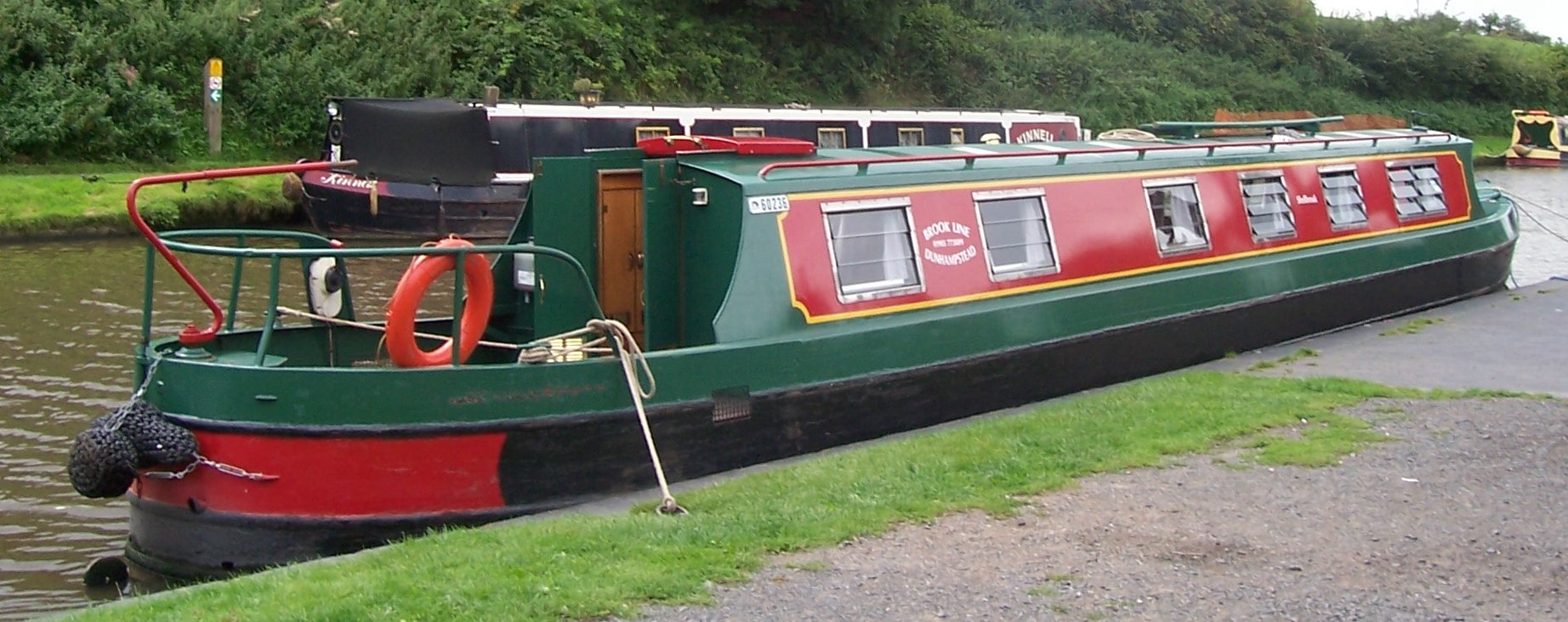 Originally these boats were more like simple barges with horses pulling them along with a rope on a tow path. With the development of compact steam engines, many became self powered and ultimately converted to diesel engines.
Originally these boats were more like simple barges with horses pulling them along with a rope on a tow path. With the development of compact steam engines, many became self powered and ultimately converted to diesel engines. 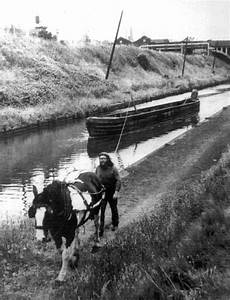 The canal system of the UK and the iconic narrow boats played a key role in the industrial revolution in England making it possible to cheaply move material throughout the country before the development of the railway system.
The canal system of the UK and the iconic narrow boats played a key role in the industrial revolution in England making it possible to cheaply move material throughout the country before the development of the railway system. 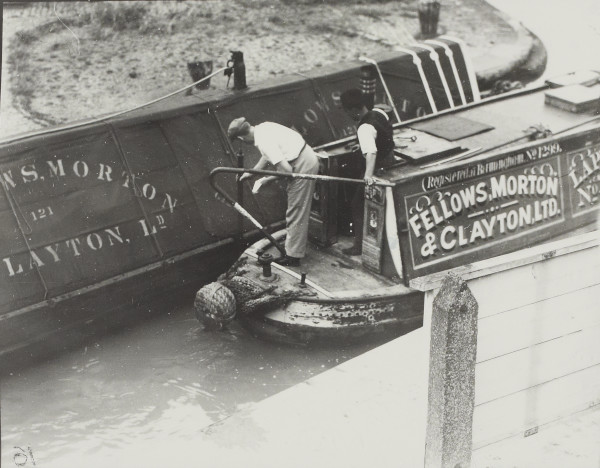 As canal traffic became the standard way to transport heavy cargo, shipping prices dropped precipitously with the cost to move coal dropping by 75%.
As canal traffic became the standard way to transport heavy cargo, shipping prices dropped precipitously with the cost to move coal dropping by 75%. 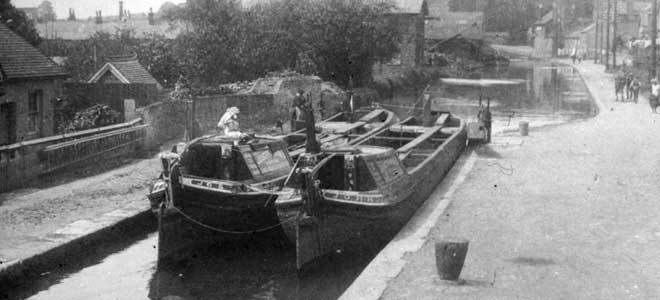 However, by the mid 20th century the canal system was all but abandoned in favor of train transport.
However, by the mid 20th century the canal system was all but abandoned in favor of train transport. Even the trains struggled with the unusually cold and snowy winter but they got through.
Even the trains struggled with the unusually cold and snowy winter but they got through. 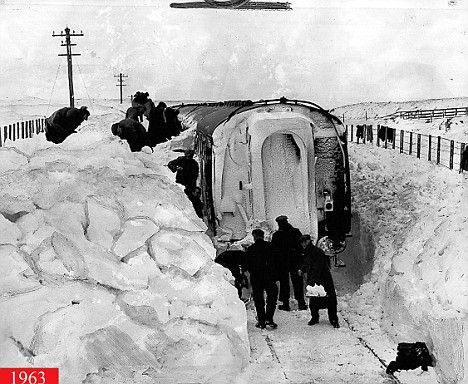 As you can imagine, it wasn’t long until much of the canal system fell into total disrepair.
As you can imagine, it wasn’t long until much of the canal system fell into total disrepair.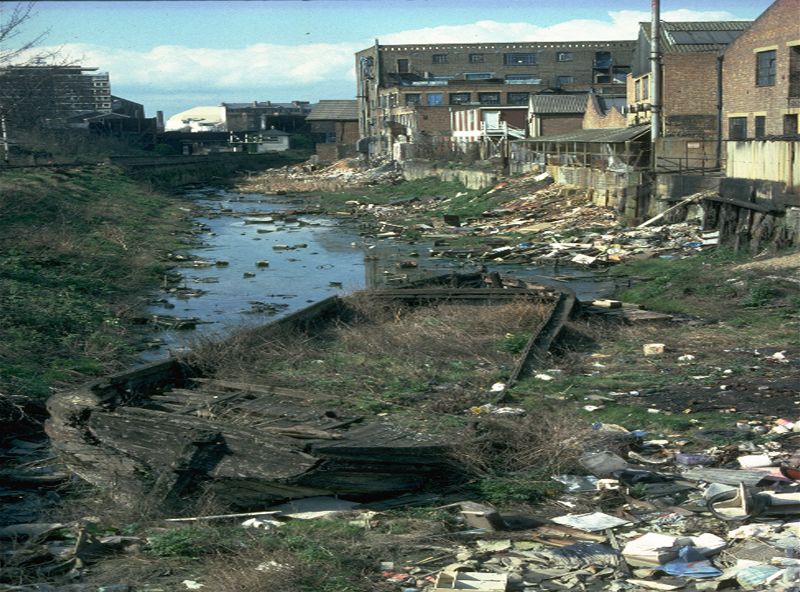 As is so often a basic truth, if you don’t use it, you loose it.
As is so often a basic truth, if you don’t use it, you loose it.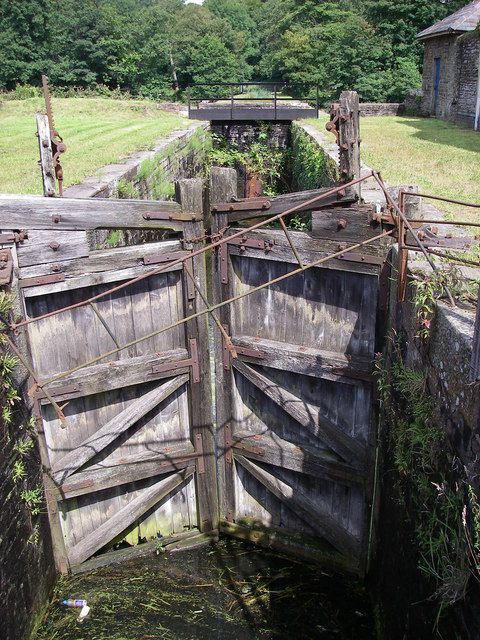 Today the system is thriving, thanks to a small group of enthusiasts that campaigned to repair the waterway. A particularly seminal moment in this reversal of fortune was the publication of the book Narrow Boat by L.T.C. Rolt, originally published in 1944. The author, Tom Rolt, brought attention to the decaying system.
Today the system is thriving, thanks to a small group of enthusiasts that campaigned to repair the waterway. A particularly seminal moment in this reversal of fortune was the publication of the book Narrow Boat by L.T.C. Rolt, originally published in 1944. The author, Tom Rolt, brought attention to the decaying system. 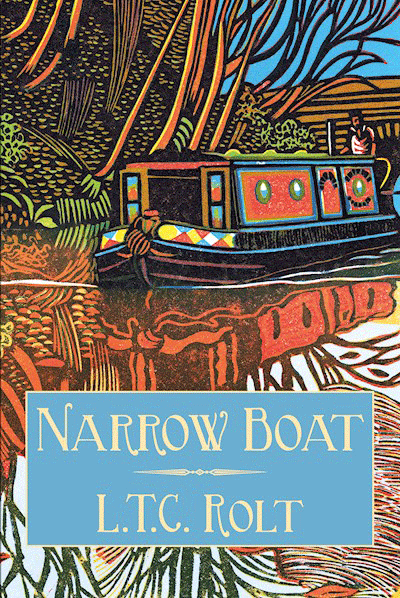 Many give credit to this book as being the catalyst that lead to the renewal of the canal system as it exists today.
Many give credit to this book as being the catalyst that lead to the renewal of the canal system as it exists today. 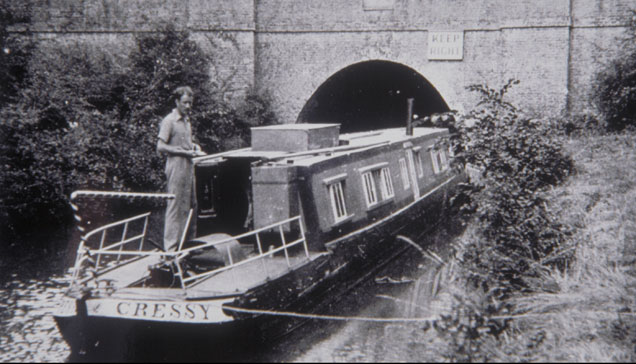
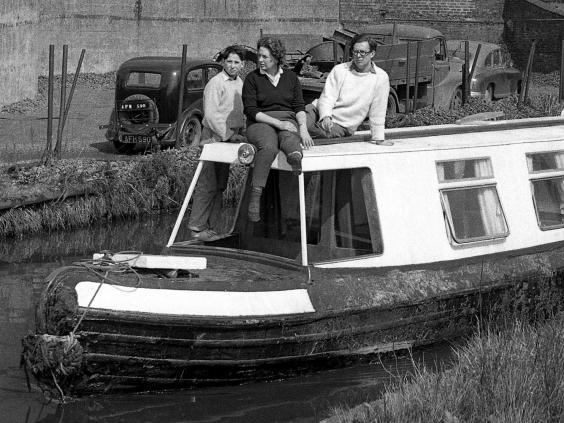 Remarkably, today there is in the neighborhood of 4,700 miles of navigable waterways in the UK with some 2,500 miles of those waterways primarily accessible by narrow boat. If you ever wonder about what can be accomplished by a single individual, consider the impact that both Rolt and Aickman had on what is now a thriving canal system with over 30,000 registered vessels in the UK alone.
Remarkably, today there is in the neighborhood of 4,700 miles of navigable waterways in the UK with some 2,500 miles of those waterways primarily accessible by narrow boat. If you ever wonder about what can be accomplished by a single individual, consider the impact that both Rolt and Aickman had on what is now a thriving canal system with over 30,000 registered vessels in the UK alone.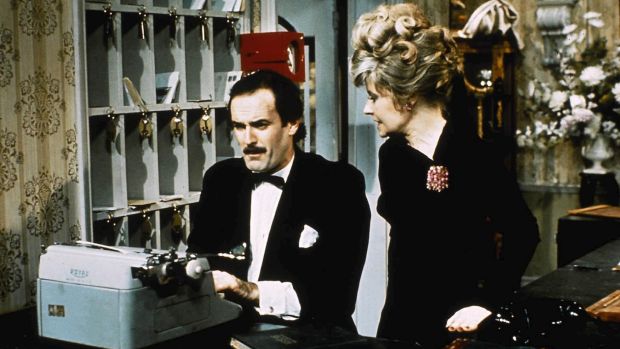 Anyway, West and Scales, who clearly have a love of canals and Narrow Boats, bring this wonderful lifestyle to life and I am hopeful that Brenda and I can find a way to fit a canal boat holiday into our trip in April.
Anyway, West and Scales, who clearly have a love of canals and Narrow Boats, bring this wonderful lifestyle to life and I am hopeful that Brenda and I can find a way to fit a canal boat holiday into our trip in April. …and long dark tunnels.
…and long dark tunnels. 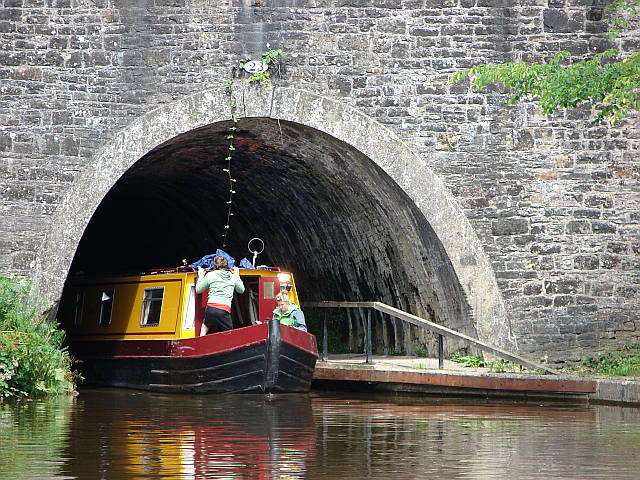
 My father did not speak much of his childhood but I do recall hearing that his parents, Wallace (Wally) and my Grandmother, Wilhelmina (Willy) Wilhelm, a good German Girl, ran a pretty tight ship and were stern with their boys, my father and his two brothers.
My father did not speak much of his childhood but I do recall hearing that his parents, Wallace (Wally) and my Grandmother, Wilhelmina (Willy) Wilhelm, a good German Girl, ran a pretty tight ship and were stern with their boys, my father and his two brothers.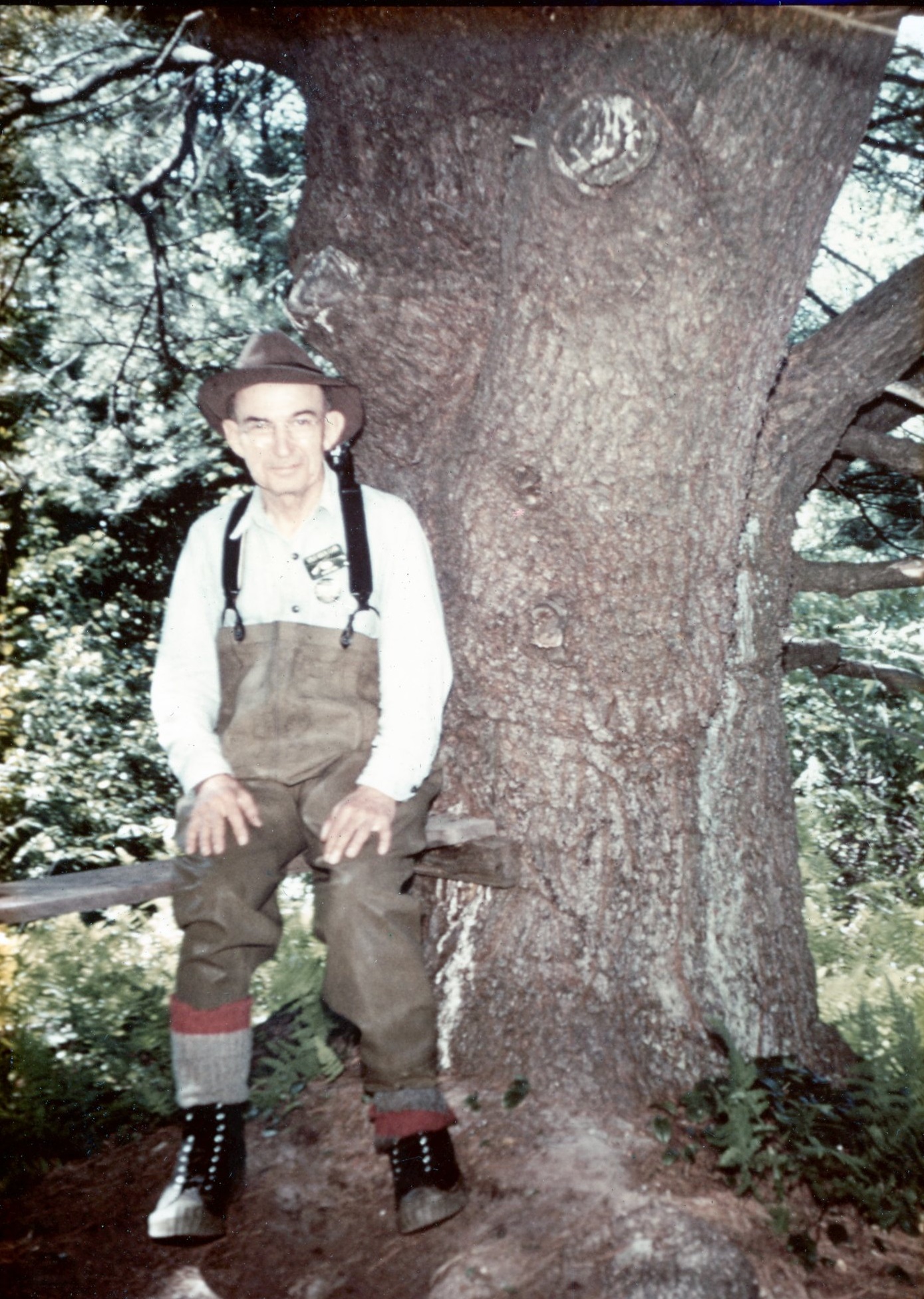
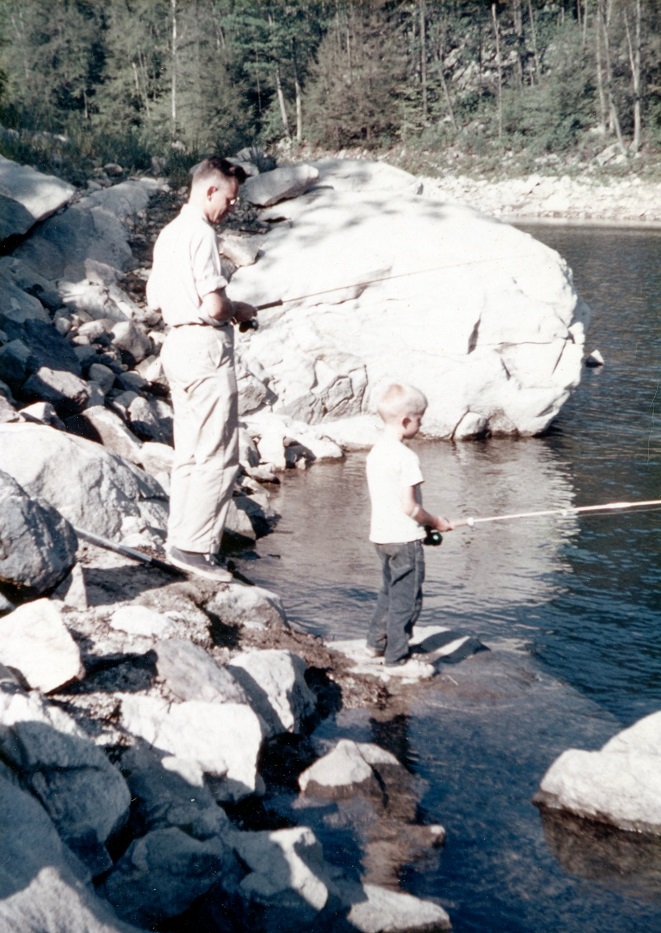
 Here they are, fording a stream, clearly in the same area, labeled “Katahadin Maine” which I learned is the highest mountain in the state. Located in the remote center of the state and I can only imagine how tough it was to get there in 1922 when this photo was taken as it was years prior to the interstate highway system.
Here they are, fording a stream, clearly in the same area, labeled “Katahadin Maine” which I learned is the highest mountain in the state. Located in the remote center of the state and I can only imagine how tough it was to get there in 1922 when this photo was taken as it was years prior to the interstate highway system. 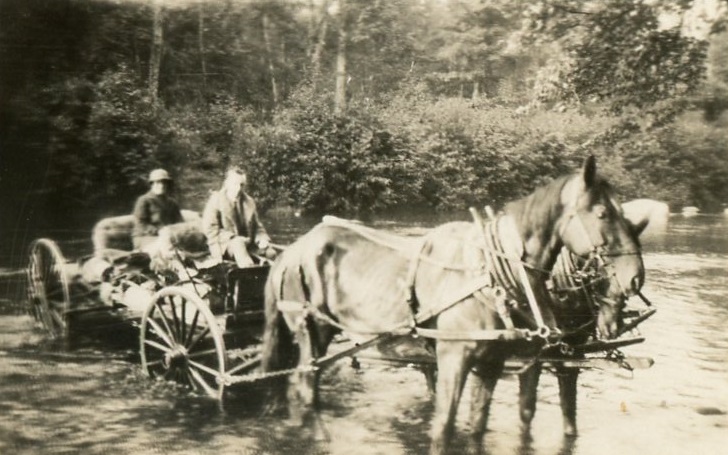
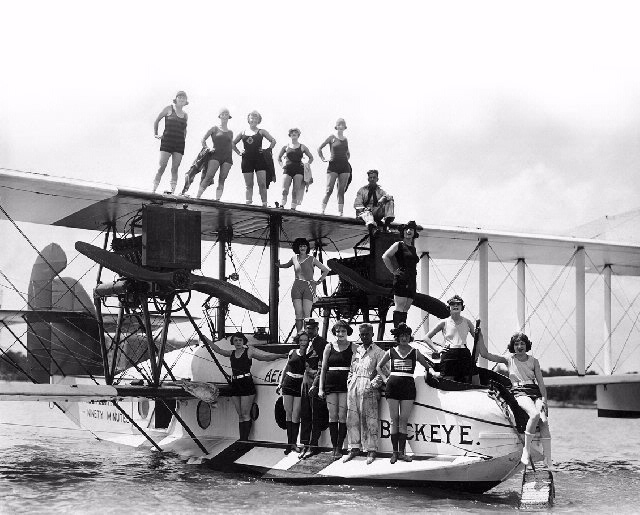
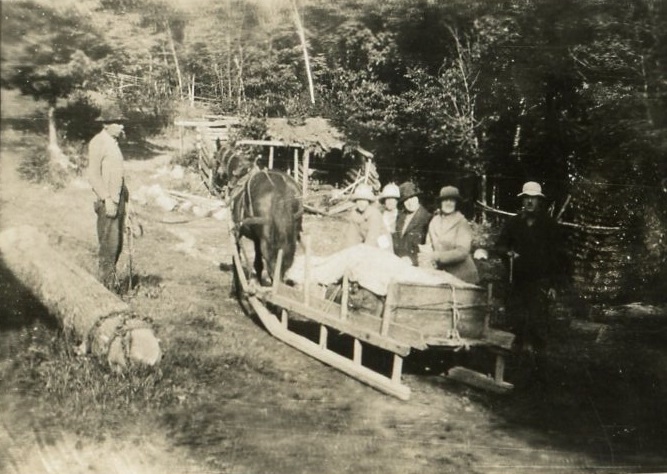 Roughing it or not, this photo, taken that same year, shows grandfather looking right at home in the backwoods, especially for a city guy. Adventuring of the sort that they did was probably not all that common at that time.
Roughing it or not, this photo, taken that same year, shows grandfather looking right at home in the backwoods, especially for a city guy. Adventuring of the sort that they did was probably not all that common at that time. 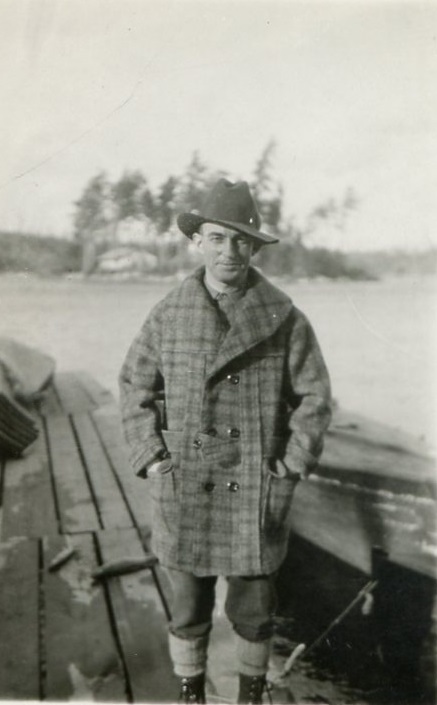 My grandmother was no shrinking violet. And here she is “packing”. Notice the sidearm. I wonder if that was before or after her encounter with that moose? Of course, as you’d expect for a proper rusticator, a skirt, appropriately below the knee, of course.
My grandmother was no shrinking violet. And here she is “packing”. Notice the sidearm. I wonder if that was before or after her encounter with that moose? Of course, as you’d expect for a proper rusticator, a skirt, appropriately below the knee, of course.  Wally packed too. It’s photo was taken some years later, in 1937, again in Newfoundland. And, of course, complete with his ever present cigarette.
Wally packed too. It’s photo was taken some years later, in 1937, again in Newfoundland. And, of course, complete with his ever present cigarette. 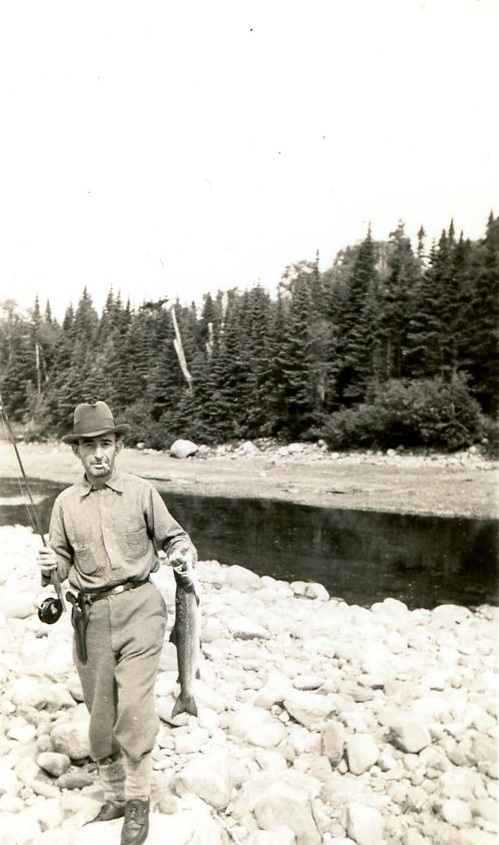 And out by the cookhouse in Newfoundland in 1940. I would imagine that they flew there as I can’t imagine having the time to get there by train, car or ship.
And out by the cookhouse in Newfoundland in 1940. I would imagine that they flew there as I can’t imagine having the time to get there by train, car or ship. 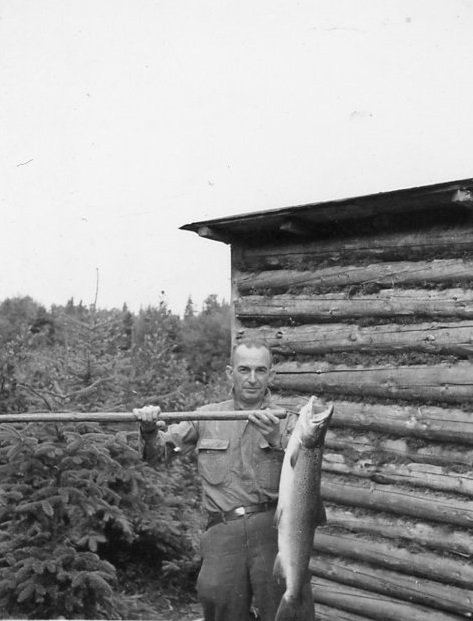 My grandmother did plenty of fishing in those years too. I remember her as pretty stern but with a great smile. When she was much older and saw me she’d say in a high pitched voice with a jaunty lilt, “little lamb, little lamb, little lamb chop, chop” and poke me in the ribs. I loved that.
My grandmother did plenty of fishing in those years too. I remember her as pretty stern but with a great smile. When she was much older and saw me she’d say in a high pitched voice with a jaunty lilt, “little lamb, little lamb, little lamb chop, chop” and poke me in the ribs. I loved that. 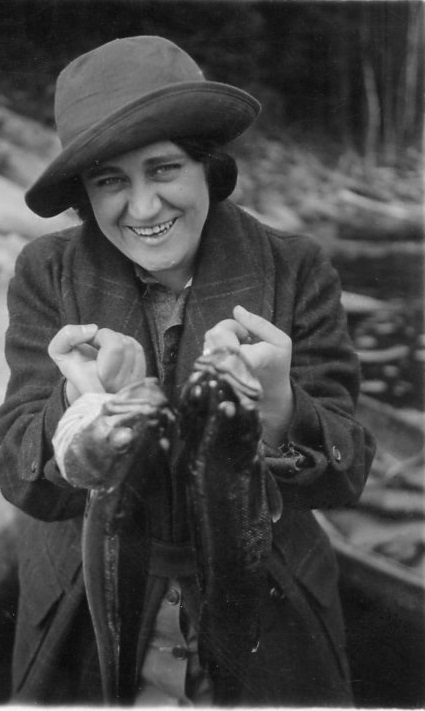 And, our Willy could handle a gun as well as a rod and reel. Love the feather in her hat.
And, our Willy could handle a gun as well as a rod and reel. Love the feather in her hat.  Looks like lunchtime with their guide. In those areas I doubt it was a good idea to go it alone. And, I expect that there was plenty of critters, large and small, that “went bump in the night” to keep an eye out for.
Looks like lunchtime with their guide. In those areas I doubt it was a good idea to go it alone. And, I expect that there was plenty of critters, large and small, that “went bump in the night” to keep an eye out for. 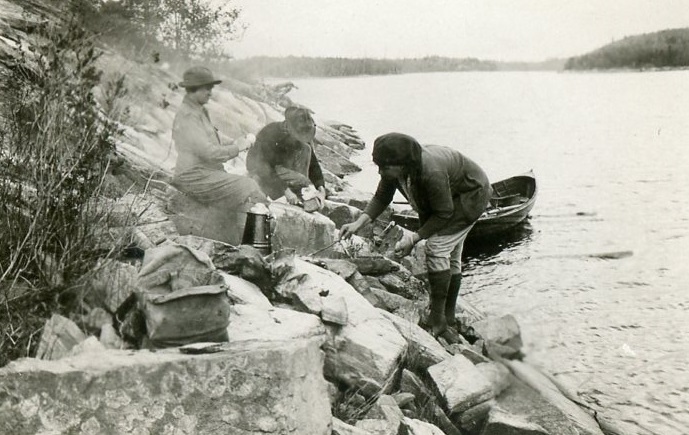 I’d love to know the story behind this moment.
I’d love to know the story behind this moment. 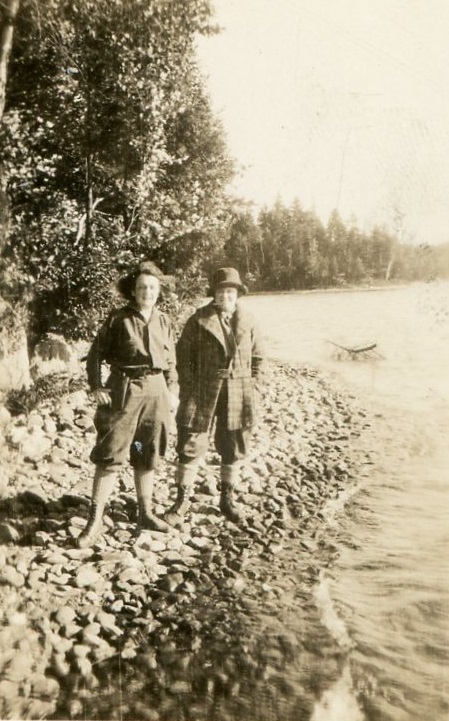 Willy could fish with the best of them it seems although she never spoke of it with me.
Willy could fish with the best of them it seems although she never spoke of it with me.  This photo, labeled only as “Maine” appears to be some sort of ferry. Imagine being out in a remote area and wearing a tie and hat these days? Heck, I even get comments at our yacht club when I show up in a bow tie.
This photo, labeled only as “Maine” appears to be some sort of ferry. Imagine being out in a remote area and wearing a tie and hat these days? Heck, I even get comments at our yacht club when I show up in a bow tie. 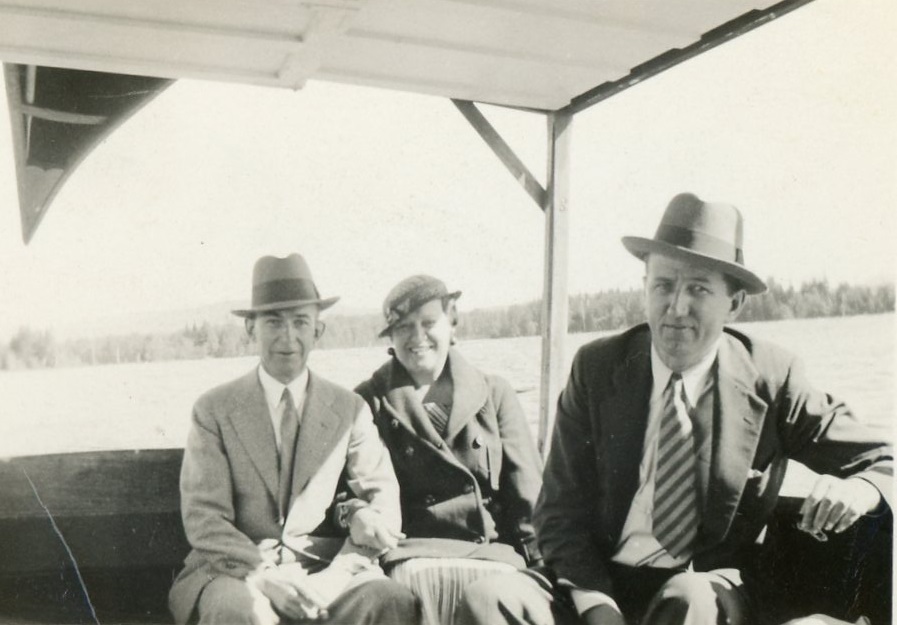 This photo carried an interesting caption on the back, “Dashing Youth, Wrecked City, Canada”. I tried but couldn’t find any reference to such an event in the 20s when I guess the photo was taken.
This photo carried an interesting caption on the back, “Dashing Youth, Wrecked City, Canada”. I tried but couldn’t find any reference to such an event in the 20s when I guess the photo was taken. 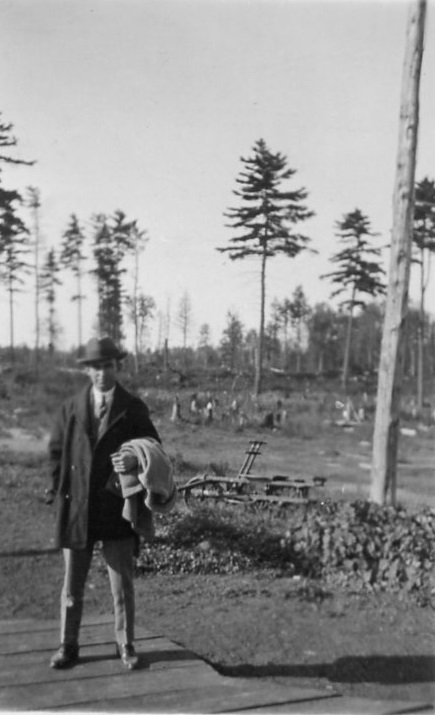 Along the way they did the tourist thing. This was taken along the
Along the way they did the tourist thing. This was taken along the 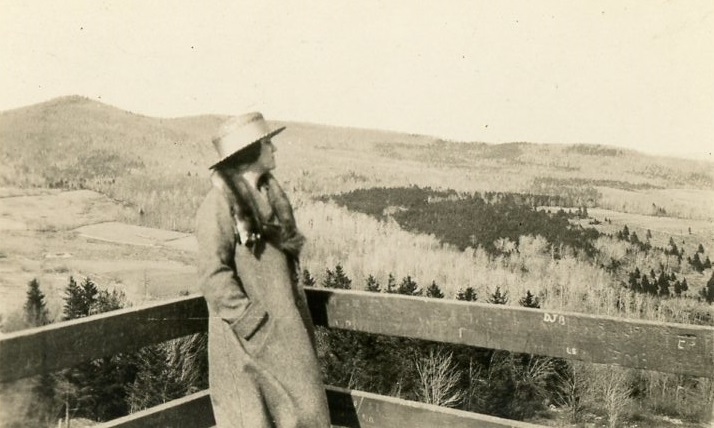 Some of the photos show my grandfather in what looks like really remote areas, like this one on a rocky riverbank, also from the early 20s. I guess that is an Atlantic Salmon. Come to think of it, all the photos look pretty remote.
Some of the photos show my grandfather in what looks like really remote areas, like this one on a rocky riverbank, also from the early 20s. I guess that is an Atlantic Salmon. Come to think of it, all the photos look pretty remote.  Legend has it that in his later years he had a standing order from a guide in the Pacific Northwest to contact him when the salmon were running and he’d hop on a plane and fly out. In those days that was a very long way as planes didn’t have nearly the range of today’s jets and had to stop every few hundred miles for fuel as they made their way from coast to coast, across the continent.
Legend has it that in his later years he had a standing order from a guide in the Pacific Northwest to contact him when the salmon were running and he’d hop on a plane and fly out. In those days that was a very long way as planes didn’t have nearly the range of today’s jets and had to stop every few hundred miles for fuel as they made their way from coast to coast, across the continent. 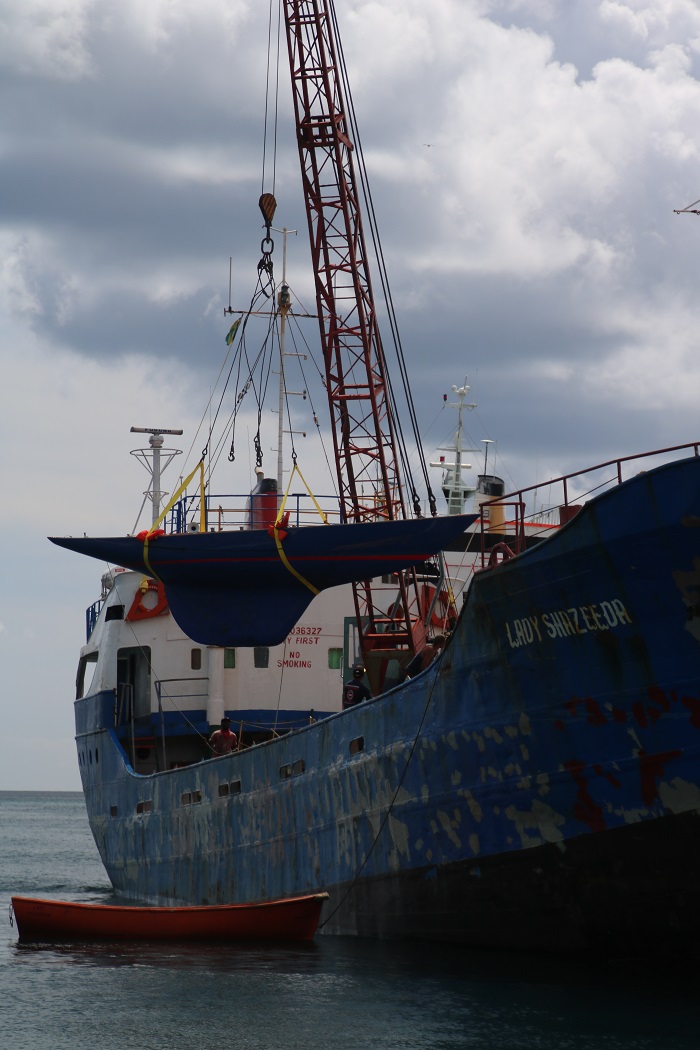 This regatta draws from nearby islands, including a number of Carriacou sloops, those beautiful traditional, beach built sloops like
This regatta draws from nearby islands, including a number of Carriacou sloops, those beautiful traditional, beach built sloops like  It’s quite a sight to see her racing around the course with her cousins.
It’s quite a sight to see her racing around the course with her cousins. 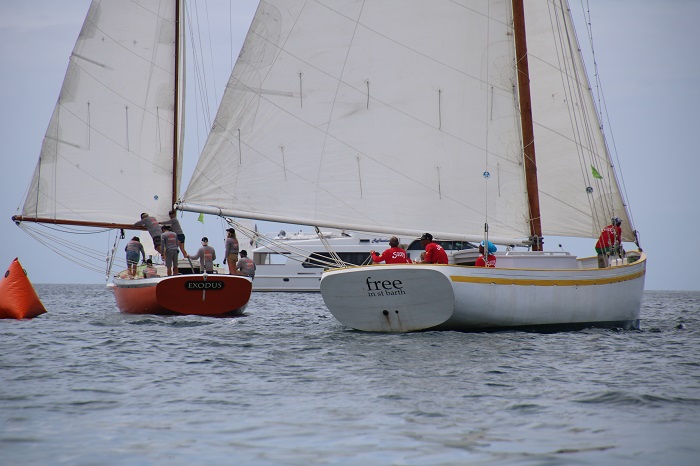 Exodus was the subject of a full length movie about her building and the history of the design. Here’s a short trailer for the movie. Check it out. If that inspires you to watch the full movie, here you go. Get a glass of rum, sit down and enjoy the show. Others came from the US like this lovely schooner Heron. She summers in Maine, chartering out of Rockport. Brenda and I will be in Maine this summer and plan on spending time in Rockport ourselves. Perhaps we’ll see her. Her captain and owner also built her and he did a great job. Want to learn more about her?
Exodus was the subject of a full length movie about her building and the history of the design. Here’s a short trailer for the movie. Check it out. If that inspires you to watch the full movie, here you go. Get a glass of rum, sit down and enjoy the show. Others came from the US like this lovely schooner Heron. She summers in Maine, chartering out of Rockport. Brenda and I will be in Maine this summer and plan on spending time in Rockport ourselves. Perhaps we’ll see her. Her captain and owner also built her and he did a great job. Want to learn more about her?  While Heron is a classic design, she’s only a few years old. Other classics participate in the regatta as well as other events in the Caribbean, such as the Antigua Classic Yacht Regatta, held in late April in Antigua. One particular beauty that was there last winter was Ma Jong, built in the 1950s. I found this particular shot of her on the Easter Regatta home page. She’s a beautiful and very powerful boat. Her home port is Vineyard Haven on Martha’s Vineyard where she was restored to her present glory.
While Heron is a classic design, she’s only a few years old. Other classics participate in the regatta as well as other events in the Caribbean, such as the Antigua Classic Yacht Regatta, held in late April in Antigua. One particular beauty that was there last winter was Ma Jong, built in the 1950s. I found this particular shot of her on the Easter Regatta home page. She’s a beautiful and very powerful boat. Her home port is Vineyard Haven on Martha’s Vineyard where she was restored to her present glory. 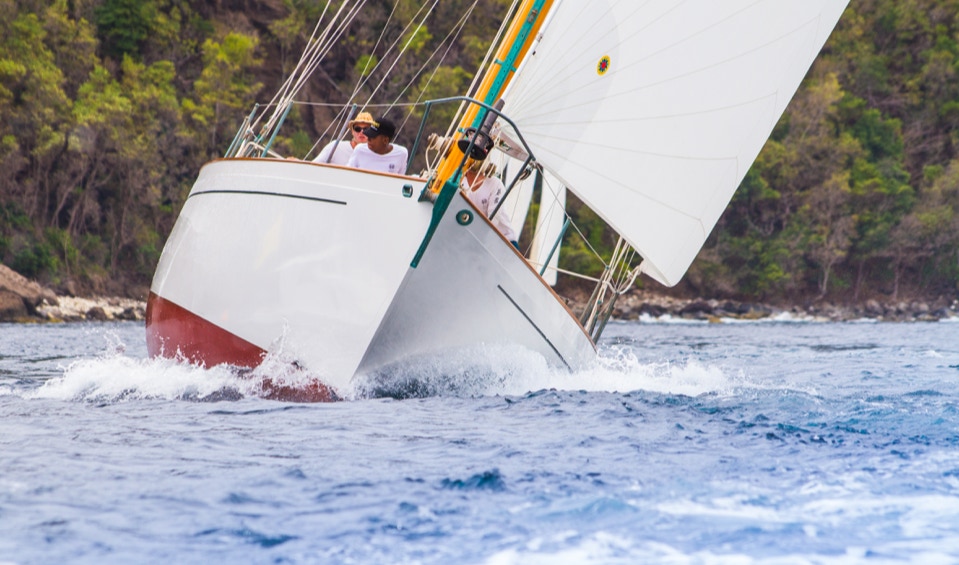 There are some good sized one design fleets in the regatta, like these vintage J24 sloops. This colorful shot is also from the regatta site.
There are some good sized one design fleets in the regatta, like these vintage J24 sloops. This colorful shot is also from the regatta site.  And, of course, there are the local Bequia sloops, built and raced on the island. You don’t have to be there during the regatta to enjoy the fun as they tack around the harbor. The local youth are out sailing these boats nearly every day, regatta or not. The youth clubhouse, oddly in a bar, is jammed with burgees brought by visitors over the years including this well used one from the Essex Yacht Club, my home club.
And, of course, there are the local Bequia sloops, built and raced on the island. You don’t have to be there during the regatta to enjoy the fun as they tack around the harbor. The local youth are out sailing these boats nearly every day, regatta or not. The youth clubhouse, oddly in a bar, is jammed with burgees brought by visitors over the years including this well used one from the Essex Yacht Club, my home club. 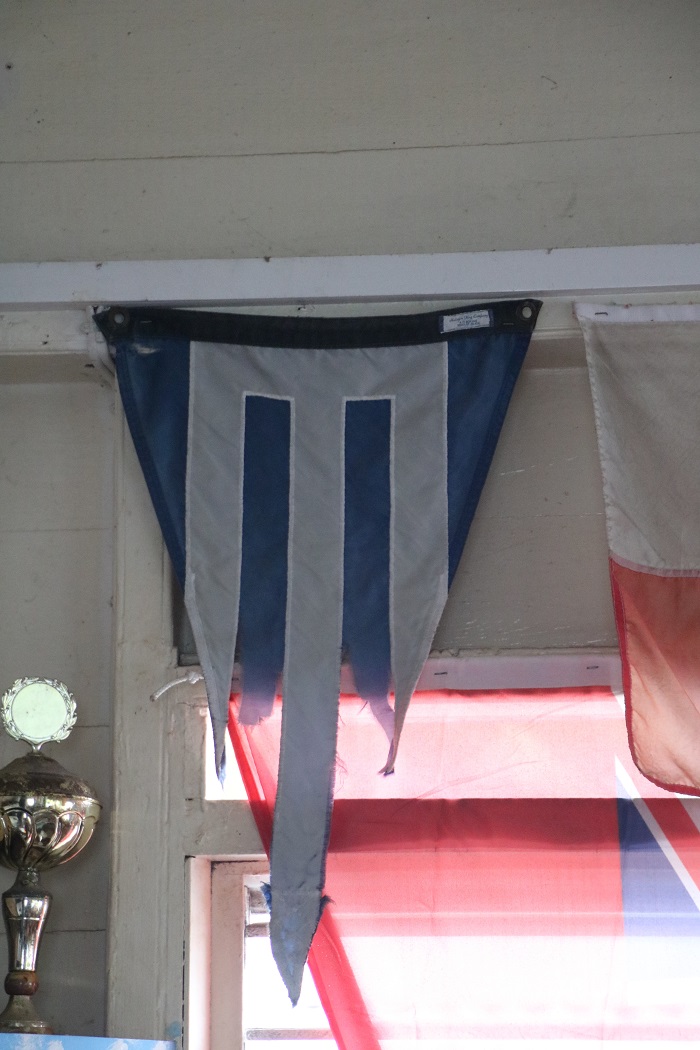 Along with boat building on the islands the history of fine craftsman goes way back including a tradition of model boats. These are fun to see and watch being built.
Along with boat building on the islands the history of fine craftsman goes way back including a tradition of model boats. These are fun to see and watch being built.  If you followed the link above, you’ll find this photo a bit repetitive as that post also included discussion about the new dink chaps we had built. Anyway, we had some great work done on the dink.
If you followed the link above, you’ll find this photo a bit repetitive as that post also included discussion about the new dink chaps we had built. Anyway, we had some great work done on the dink. 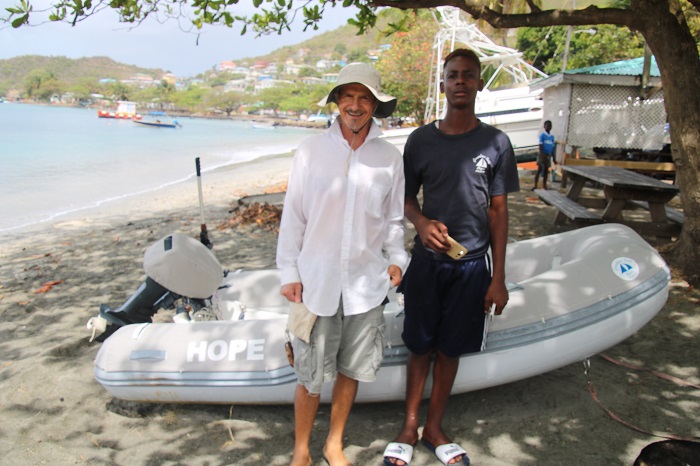 Pandora’s varnish below was freshened too.
Pandora’s varnish below was freshened too.  There’s plenty to do ashore during the regatta including all manner of competitions. Everything from musical chairs on stage to threading the needle, yes threading sewing needles. Brenda competed and won, with a little help from a local and no doubt mortified, young man. They were both good sports.
There’s plenty to do ashore during the regatta including all manner of competitions. Everything from musical chairs on stage to threading the needle, yes threading sewing needles. Brenda competed and won, with a little help from a local and no doubt mortified, young man. They were both good sports.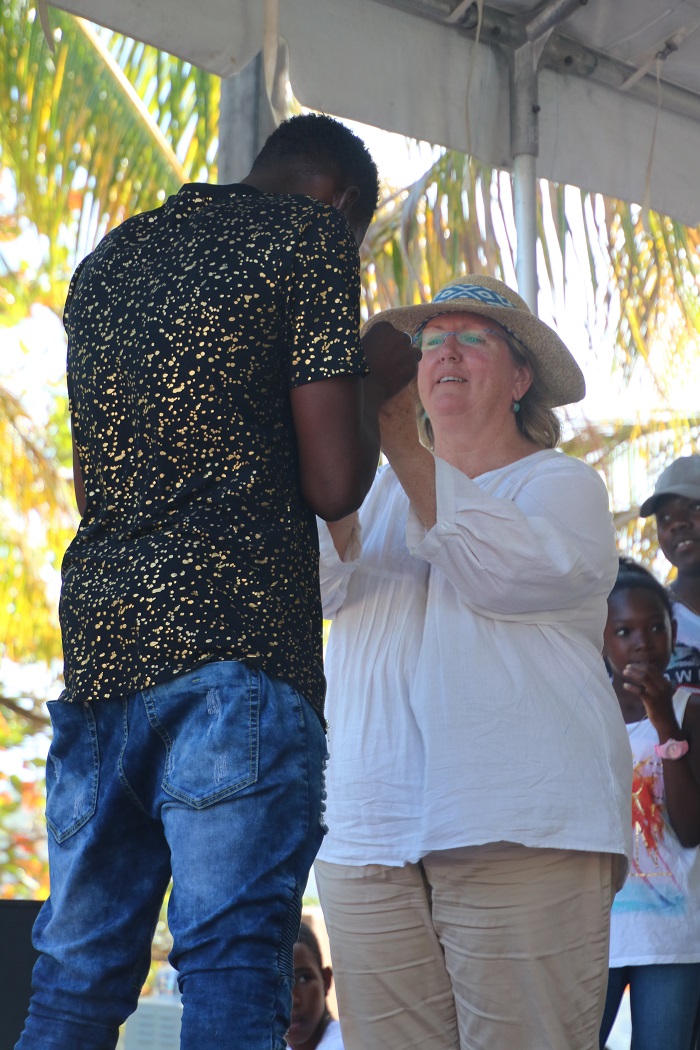 Checking into Bequia is easy if more expensive than the French islands. Just about all of the islands from St Vincent, south through the Grenadines, to just north of Grenada, are all part of the same jurisdiction.
Checking into Bequia is easy if more expensive than the French islands. Just about all of the islands from St Vincent, south through the Grenadines, to just north of Grenada, are all part of the same jurisdiction. Everything about the harbor is colorful including the ferry boats from St Vincent.
Everything about the harbor is colorful including the ferry boats from St Vincent.  With all manner of local boats pulled up on the beach.
With all manner of local boats pulled up on the beach.  We enjoy checking out local eateries and there are plenty to choose from, convenient from the walkway ringing the southern side of the harbor.
We enjoy checking out local eateries and there are plenty to choose from, convenient from the walkway ringing the southern side of the harbor.  I have used this shot before. To me, it perfectly evokes the image from the much loved classic book, The Wind in the Willows, when Ratty famously says, “Believe me, my young friend, there is nothing – absolutely nothing – half so much worth doing as simply messing about in boats.”
I have used this shot before. To me, it perfectly evokes the image from the much loved classic book, The Wind in the Willows, when Ratty famously says, “Believe me, my young friend, there is nothing – absolutely nothing – half so much worth doing as simply messing about in boats.”  Well, there you have it, Bequia, o
Well, there you have it, Bequia, o The Salty Dawg Sailing Association, a group that in only a few short years became the organizers of what is now the largest rally to the Caribbean from the US East Coast. SDSA, is dedicated to educating sailors and their crew to prepare for the rigors of offshore sailing and they do a wonderful job at it. It’s very exciting to be part of the nearly week long events in Hampton VA as skippers and crew from nearly 100 boats attend seminars, have parties and get ready to head south.
The Salty Dawg Sailing Association, a group that in only a few short years became the organizers of what is now the largest rally to the Caribbean from the US East Coast. SDSA, is dedicated to educating sailors and their crew to prepare for the rigors of offshore sailing and they do a wonderful job at it. It’s very exciting to be part of the nearly week long events in Hampton VA as skippers and crew from nearly 100 boats attend seminars, have parties and get ready to head south.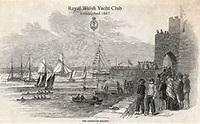
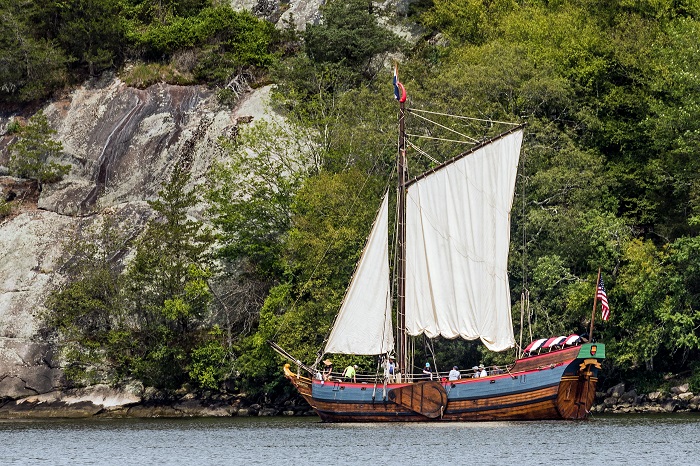 Just a bit farther up the river is Selden Creek, a really narrow and beautiful, cut off of the river. It can be tough to get over the bar at the entrance but once but once you are inside, it’s plenty deep and stunning. You can anchor fore and aft if you tie up to a spot on the bank. There’s an iron ring cemented into a cliff on the bank. This was our first Pandora, a SAGA 43 tied up there, way back in 2007.
Just a bit farther up the river is Selden Creek, a really narrow and beautiful, cut off of the river. It can be tough to get over the bar at the entrance but once but once you are inside, it’s plenty deep and stunning. You can anchor fore and aft if you tie up to a spot on the bank. There’s an iron ring cemented into a cliff on the bank. This was our first Pandora, a SAGA 43 tied up there, way back in 2007. As tempting as it may be to climb up the rock and jump into the water, don’t do it as it’s private property. Years ago, our son Rob broke the rules. Don’t tell anyone.
As tempting as it may be to climb up the rock and jump into the water, don’t do it as it’s private property. Years ago, our son Rob broke the rules. Don’t tell anyone. 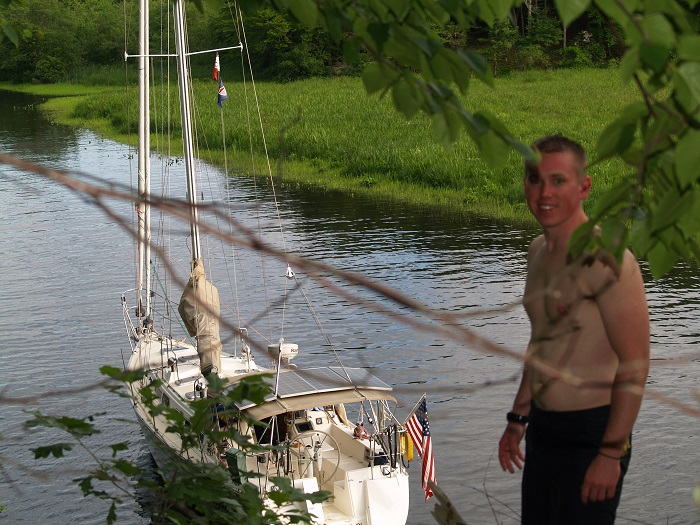 He and a friend jumped off of the “private” rock.
He and a friend jumped off of the “private” rock.  What goes up, must come down.
What goes up, must come down.
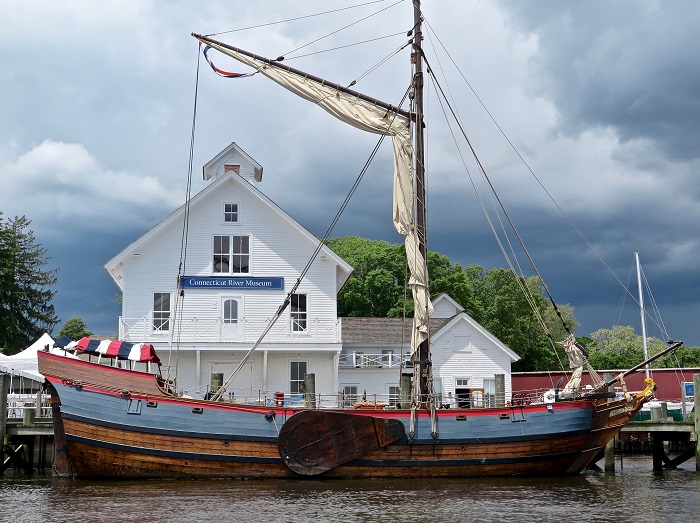 Essex Harbor is quite large and while there are lots of moorings for rent, there is also plenty of room to anchor on the far side of the river. This shot, from the air, is compliments of the CT River Museum.
Essex Harbor is quite large and while there are lots of moorings for rent, there is also plenty of room to anchor on the far side of the river. This shot, from the air, is compliments of the CT River Museum.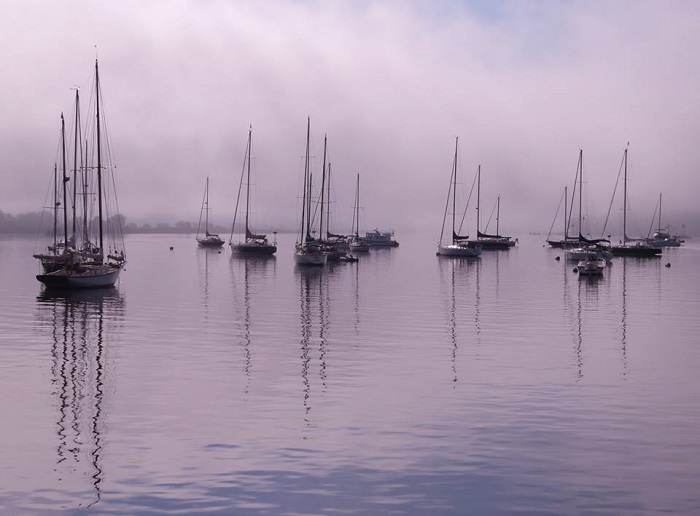 There’s plenty to do in Essex, after hours. A particularly popular spot is the bar in the Griswold Inn, known locally as simply, The Gris. It’s one of the oldest, or perhaps the oldest, pubs in the country, operating continuously since 1776.
There’s plenty to do in Essex, after hours. A particularly popular spot is the bar in the Griswold Inn, known locally as simply, The Gris. It’s one of the oldest, or perhaps the oldest, pubs in the country, operating continuously since 1776.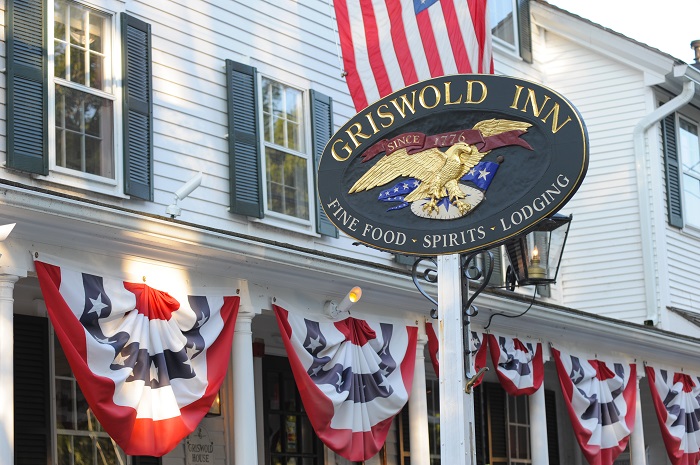 My favorite event, held every Monday night at the Gris, is sea chanteys performed by the group the
My favorite event, held every Monday night at the Gris, is sea chanteys performed by the group the 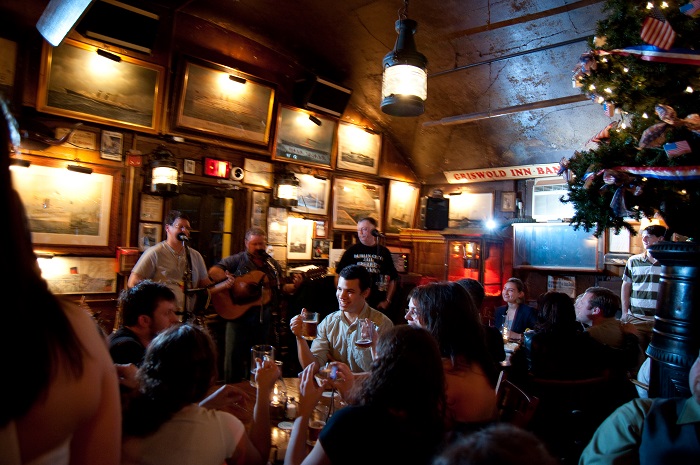 And, let’s not forget the Essex Yacht Club, where the event will be held, with Pandora conveniently out in front in this shot.
And, let’s not forget the Essex Yacht Club, where the event will be held, with Pandora conveniently out in front in this shot.  The agenda is coming along nicely and will include a program on weather routing by
The agenda is coming along nicely and will include a program on weather routing by 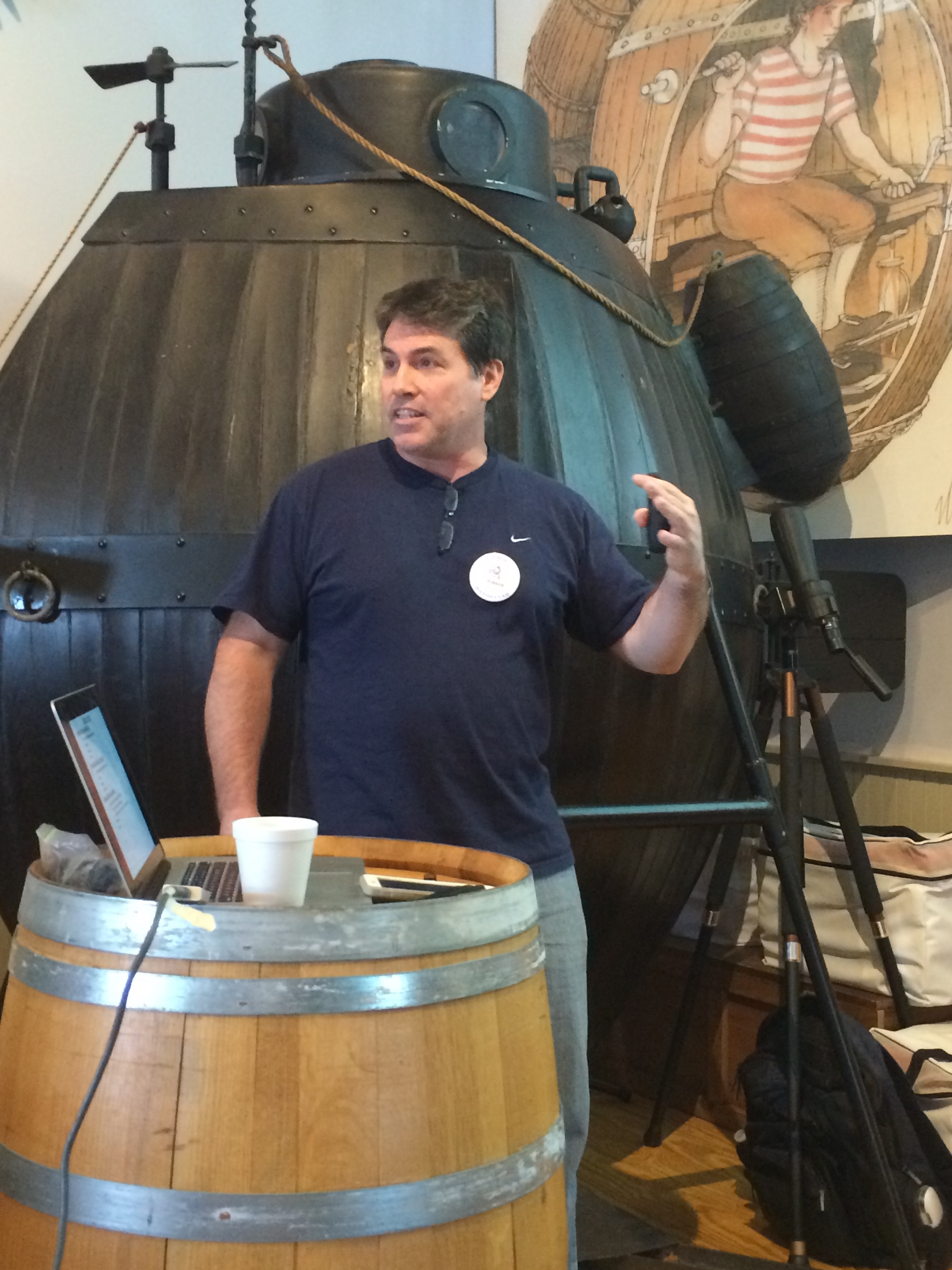 We’ll also have talks about cruising in Maine, the Bahamas and the Caribbean. All with a bent toward blue water sailing.
We’ll also have talks about cruising in Maine, the Bahamas and the Caribbean. All with a bent toward blue water sailing.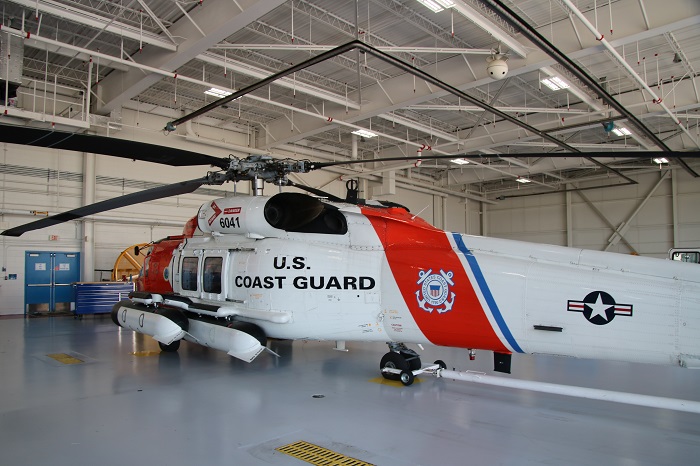 Well, there’s still more in the planning stages but George and I are really excited about how things shaping up so stay tuned to learn more.
Well, there’s still more in the planning stages but George and I are really excited about how things shaping up so stay tuned to learn more. I fell in love with the traditional boats of the area. Perhaps the most iconic boat design of the region is the Guide Boat, so named because it was used for hunting and fishing by “sports” who visited the region by train from NYC to “rusticate”, beginning in the years after the close of the Civil War. These boats were crewed by the builders themselves, who spent winters building the boats and summers taking visitors on guided hunting and fishing trips. Guide boats are known for being easy to row and for being able to carry a lot of gear and as they had to as often it was a hunter, guide and any game that they may have bagged.
I fell in love with the traditional boats of the area. Perhaps the most iconic boat design of the region is the Guide Boat, so named because it was used for hunting and fishing by “sports” who visited the region by train from NYC to “rusticate”, beginning in the years after the close of the Civil War. These boats were crewed by the builders themselves, who spent winters building the boats and summers taking visitors on guided hunting and fishing trips. Guide boats are known for being easy to row and for being able to carry a lot of gear and as they had to as often it was a hunter, guide and any game that they may have bagged.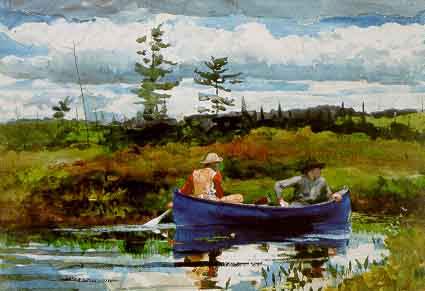 I got the bug to have one of these beautiful boats but couldn’t afford to buy a “real” one. Instead, I found someone who was offering a “bare hull” in Kevlar which I finished with walnut decks and cane seats. I even carved out oars to pretty exact specs. This is one sweet boat to row and very light.
I got the bug to have one of these beautiful boats but couldn’t afford to buy a “real” one. Instead, I found someone who was offering a “bare hull” in Kevlar which I finished with walnut decks and cane seats. I even carved out oars to pretty exact specs. This is one sweet boat to row and very light.  The hull and fitting design were taken off of the lines of a particular boat “Ghost”, built by H.D Grant. The original boat is now in the collection of the Adirondack Museum, renamed the
The hull and fitting design were taken off of the lines of a particular boat “Ghost”, built by H.D Grant. The original boat is now in the collection of the Adirondack Museum, renamed the 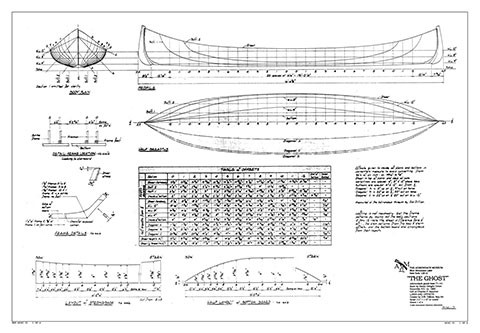 The plans even specify details down to the oarlocks which I was able to purchase from a foundry that had duplicated the design to be true to the original.
The plans even specify details down to the oarlocks which I was able to purchase from a foundry that had duplicated the design to be true to the original.  This design of boats has been remarkably popular for over 100 years and there are still boats being constructed using the exact same techniques and materials. These boats are very tough to make as the materials are impossibly thin to keep the weight of the boats to a minimum given the need to portage, or hand carry, from one lake to the next.
This design of boats has been remarkably popular for over 100 years and there are still boats being constructed using the exact same techniques and materials. These boats are very tough to make as the materials are impossibly thin to keep the weight of the boats to a minimum given the need to portage, or hand carry, from one lake to the next.  There were many hotels dotting the lakes that featured guideboats for hire, complete with guides.
There were many hotels dotting the lakes that featured guideboats for hire, complete with guides. We had many wonderful times heading out on picnics on the lake and nearby St Regis Lake. Wow, what a dish. Nice boat too.
We had many wonderful times heading out on picnics on the lake and nearby St Regis Lake. Wow, what a dish. Nice boat too. 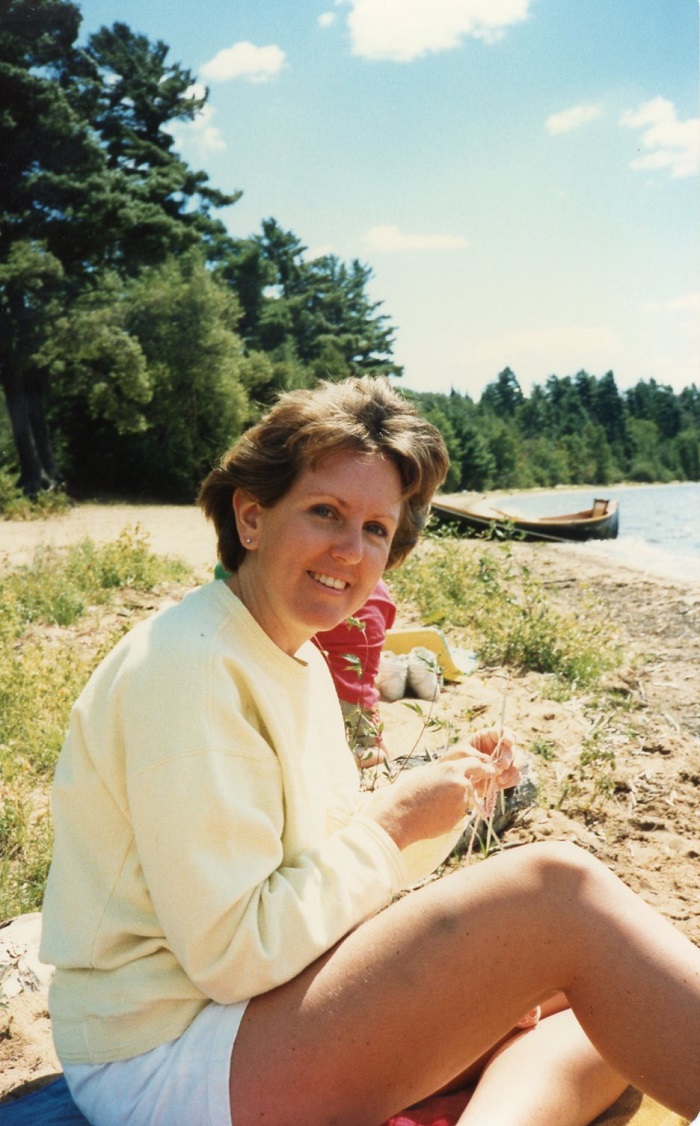 St Regis Lake was and is still today, home to many of the “Great Camps” where wealthy city dwellers would spend time “rusticating” in somewhat less than rustic conditions.
St Regis Lake was and is still today, home to many of the “Great Camps” where wealthy city dwellers would spend time “rusticating” in somewhat less than rustic conditions.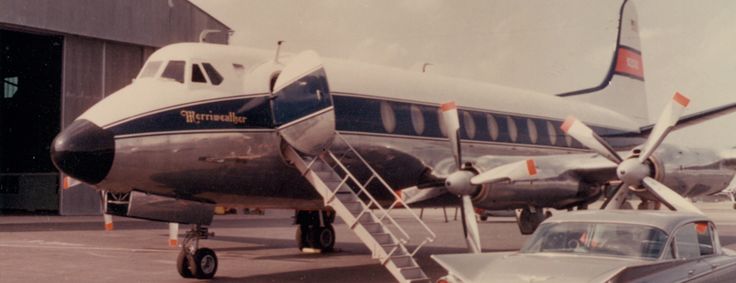 While there was eventually there was a service road to the estate, during Post’s ownership all materials and visitors arrived by water, landing at this magnificent boathouse. The largest building for the estate, above the boathouse, featured what was, at the time, the largest piece of plate glass in the area, offering a beautiful view of the lake.
While there was eventually there was a service road to the estate, during Post’s ownership all materials and visitors arrived by water, landing at this magnificent boathouse. The largest building for the estate, above the boathouse, featured what was, at the time, the largest piece of plate glass in the area, offering a beautiful view of the lake. 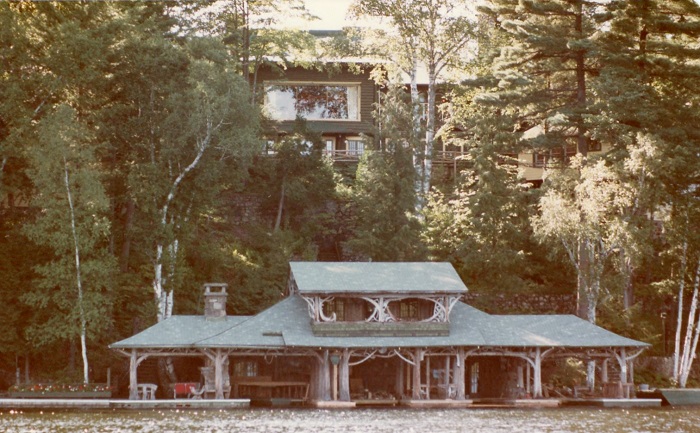 Following her death in 1973, she willed the compound to NY State that used it as a retreat for a number of years. During that period it was open to the public so Brenda and I visited. The state eventually sold the property to the flamboyant Roger Jakubowski, who had made millions selling hotdogs in the NY City area.
Following her death in 1973, she willed the compound to NY State that used it as a retreat for a number of years. During that period it was open to the public so Brenda and I visited. The state eventually sold the property to the flamboyant Roger Jakubowski, who had made millions selling hotdogs in the NY City area.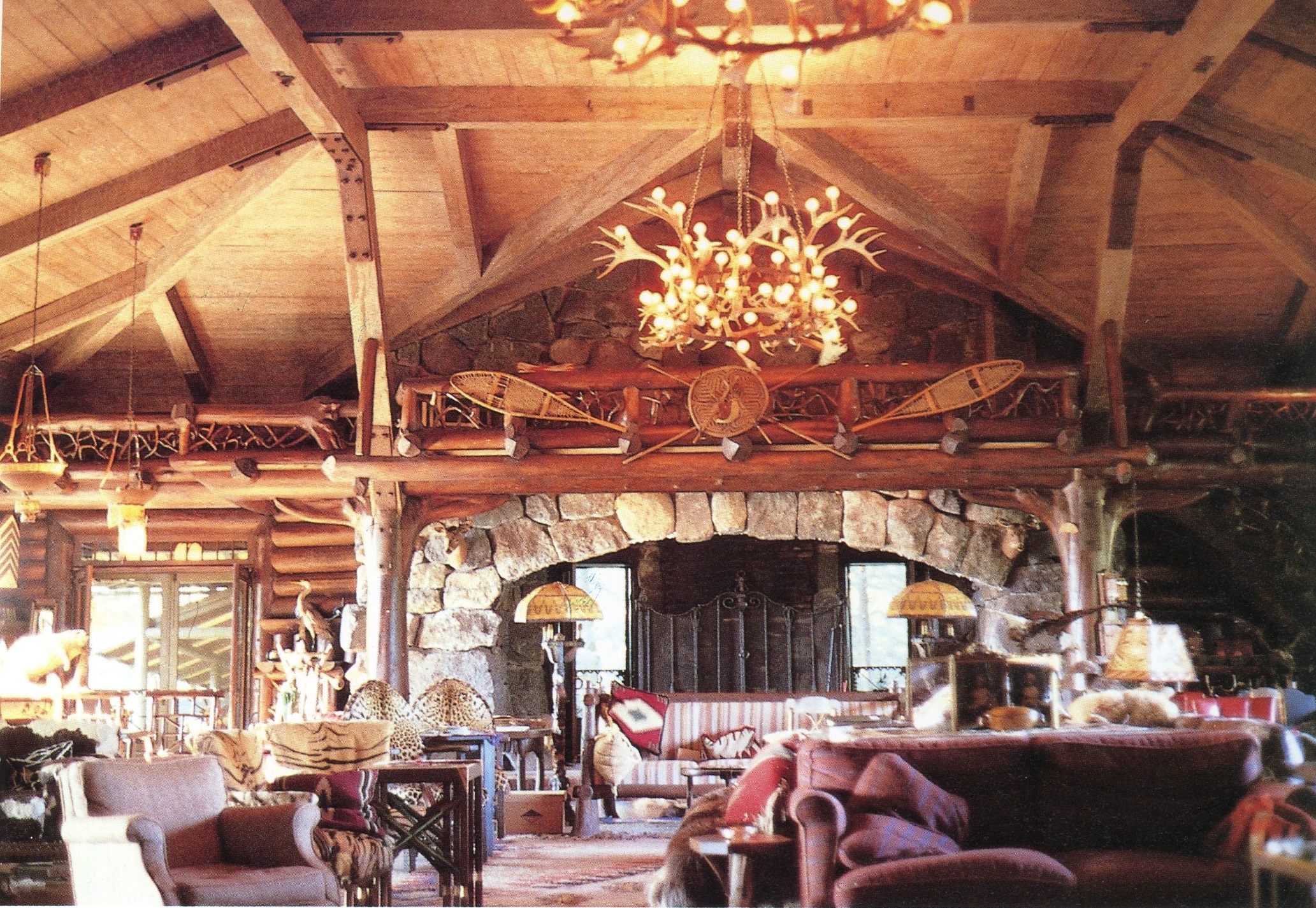 Anyway, the estate is now owned by Hartlan Crow, a developer from Texas, who has substantially restored the camp.
Anyway, the estate is now owned by Hartlan Crow, a developer from Texas, who has substantially restored the camp.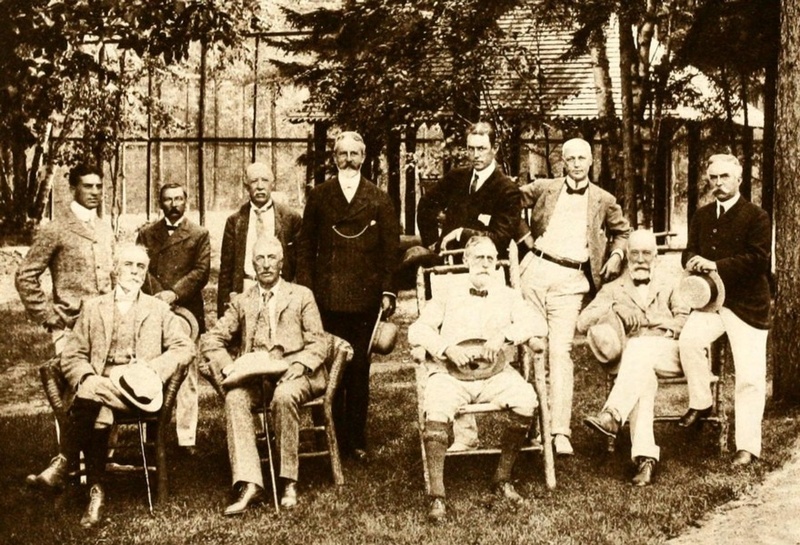 Here’s a shot of them racing in 1900.
Here’s a shot of them racing in 1900.  Those same boats racing 100 years later.
Those same boats racing 100 years later.  This is one we saw when Brenda and I visited the lake in our guideboat.
This is one we saw when Brenda and I visited the lake in our guideboat. 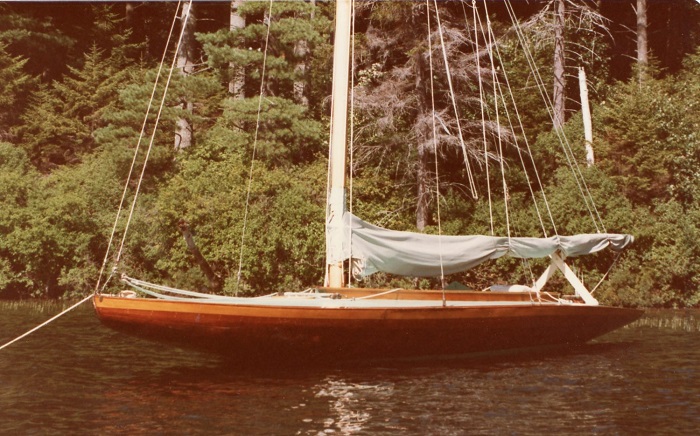 One of the original dozen that were built is now on display in the Adirondack Museum with all of the others lovingly maintained and still kept on the lake. In 2004 a new boat was built to the class so that now, once again, there are a dozen boats on the lake that race together.
One of the original dozen that were built is now on display in the Adirondack Museum with all of the others lovingly maintained and still kept on the lake. In 2004 a new boat was built to the class so that now, once again, there are a dozen boats on the lake that race together.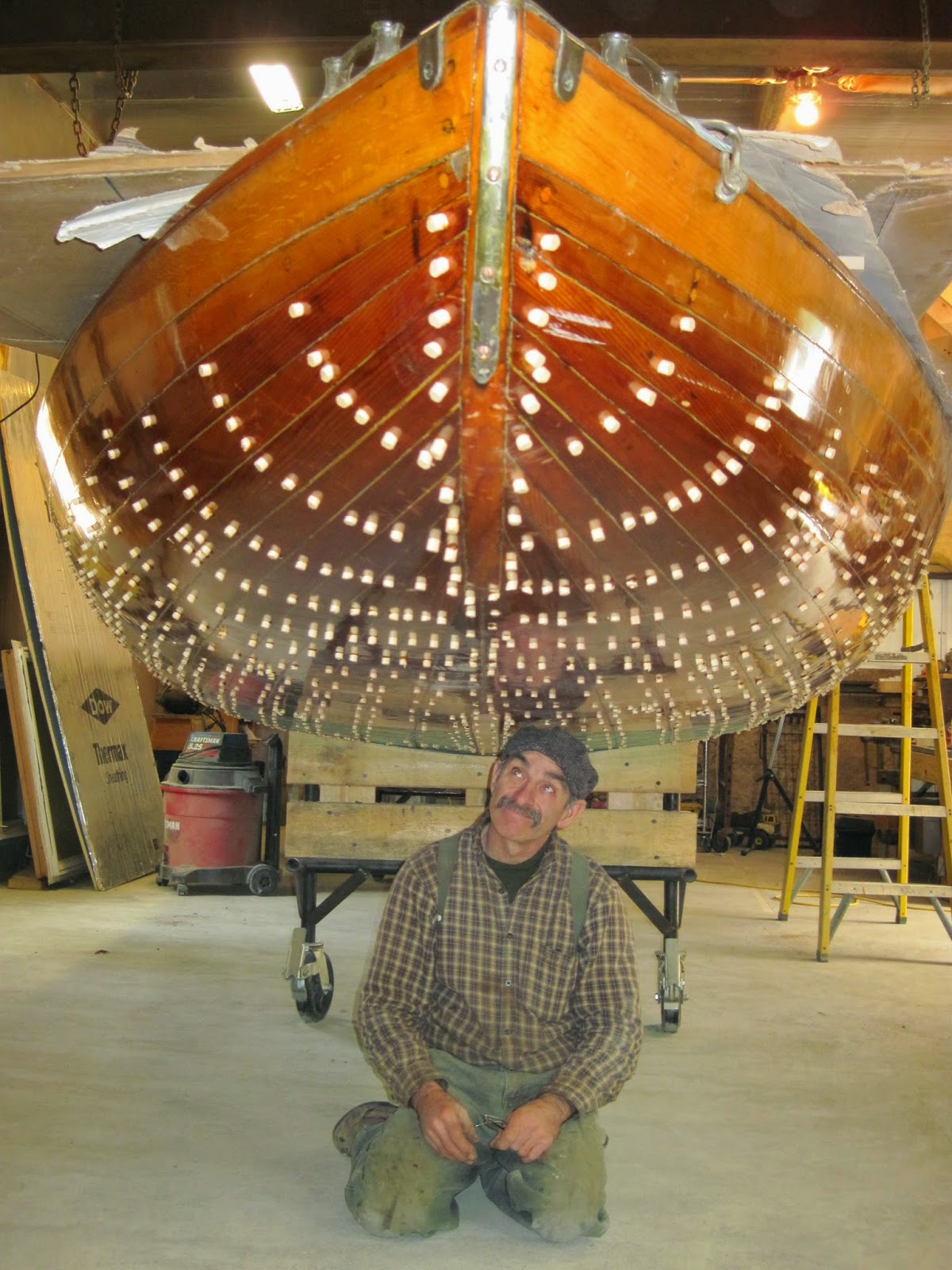 When Post married for the second time, it was to E.F. Hutton and subsequently she and Hutton were the owners of
When Post married for the second time, it was to E.F. Hutton and subsequently she and Hutton were the owners of 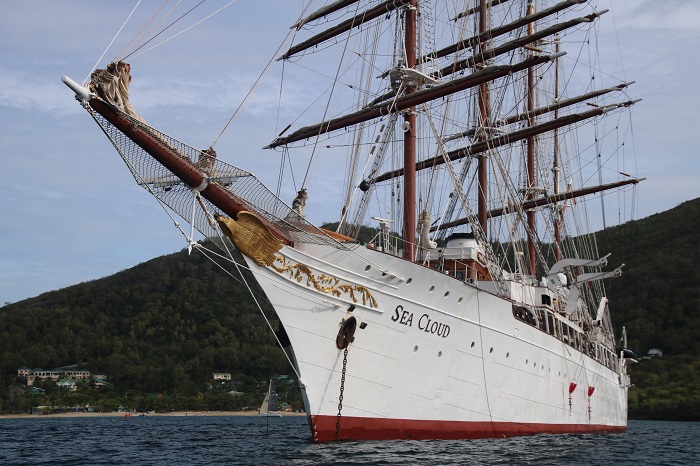 Post was also the builder and first owner of Mar-a-Lago, now owned by our current president, Trump, if somehow you missed his tweet reminding you.
Post was also the builder and first owner of Mar-a-Lago, now owned by our current president, Trump, if somehow you missed his tweet reminding you.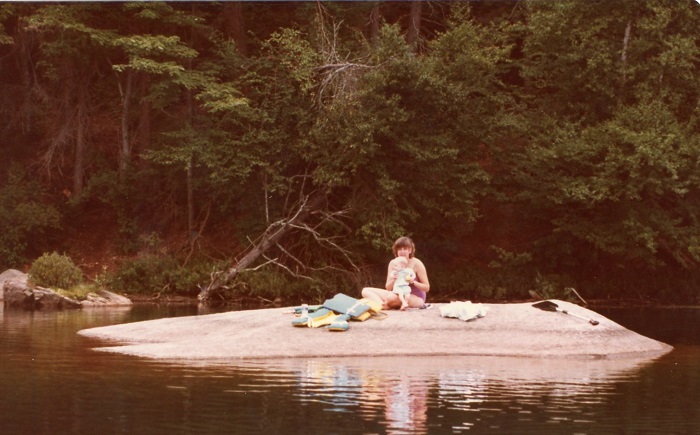 Anyway, visiting Lake Clear was a big part of my early years as well as when Brenda and I were newly married. We spent many hours around the proverbial campfire at the Lathrop’s cabin nearby, first with just Rob and then Chris too.
Anyway, visiting Lake Clear was a big part of my early years as well as when Brenda and I were newly married. We spent many hours around the proverbial campfire at the Lathrop’s cabin nearby, first with just Rob and then Chris too.  The four of us went on outings in the Guideboat.
The four of us went on outings in the Guideboat.  And sat on the dock.
And sat on the dock. 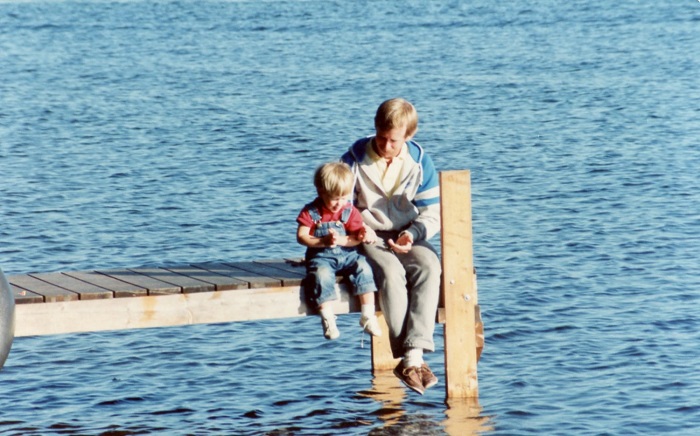 In our early years together, we rented a cabin with my parents. This is them on the top of Whiteface mountain. My mom is now nearly 90 and my dad’s been gone for about 5 years. He was a great guy and I think about him every day and still miss him terribly. Personally, I think he should have been given more time for “good behavior”.
In our early years together, we rented a cabin with my parents. This is them on the top of Whiteface mountain. My mom is now nearly 90 and my dad’s been gone for about 5 years. He was a great guy and I think about him every day and still miss him terribly. Personally, I think he should have been given more time for “good behavior”. 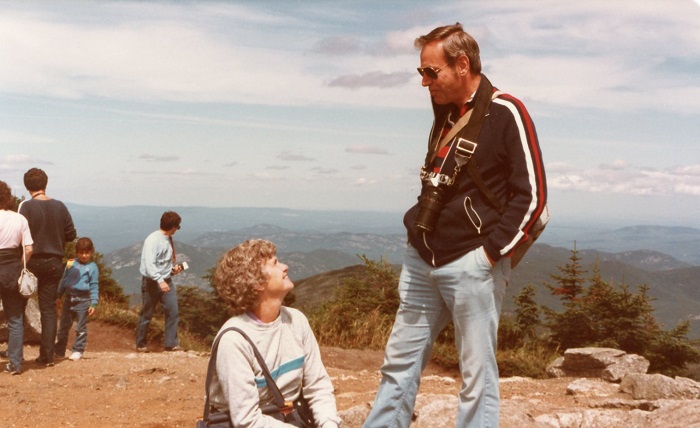 Not sure what this was all about but there were lots of shenanigans while the Osborn clan was visiting.
Not sure what this was all about but there were lots of shenanigans while the Osborn clan was visiting.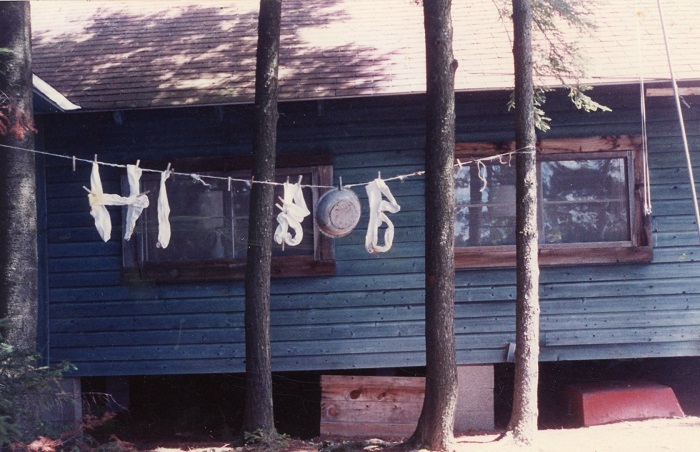 These days I am still very much a boat lover and spend as much time afloat as I can but then you already know that. Today we spend more of our time on salt water with the sweet kind which is limited to our time on the CT River near our home.
These days I am still very much a boat lover and spend as much time afloat as I can but then you already know that. Today we spend more of our time on salt water with the sweet kind which is limited to our time on the CT River near our home.